American Indian Baskets (Apache)
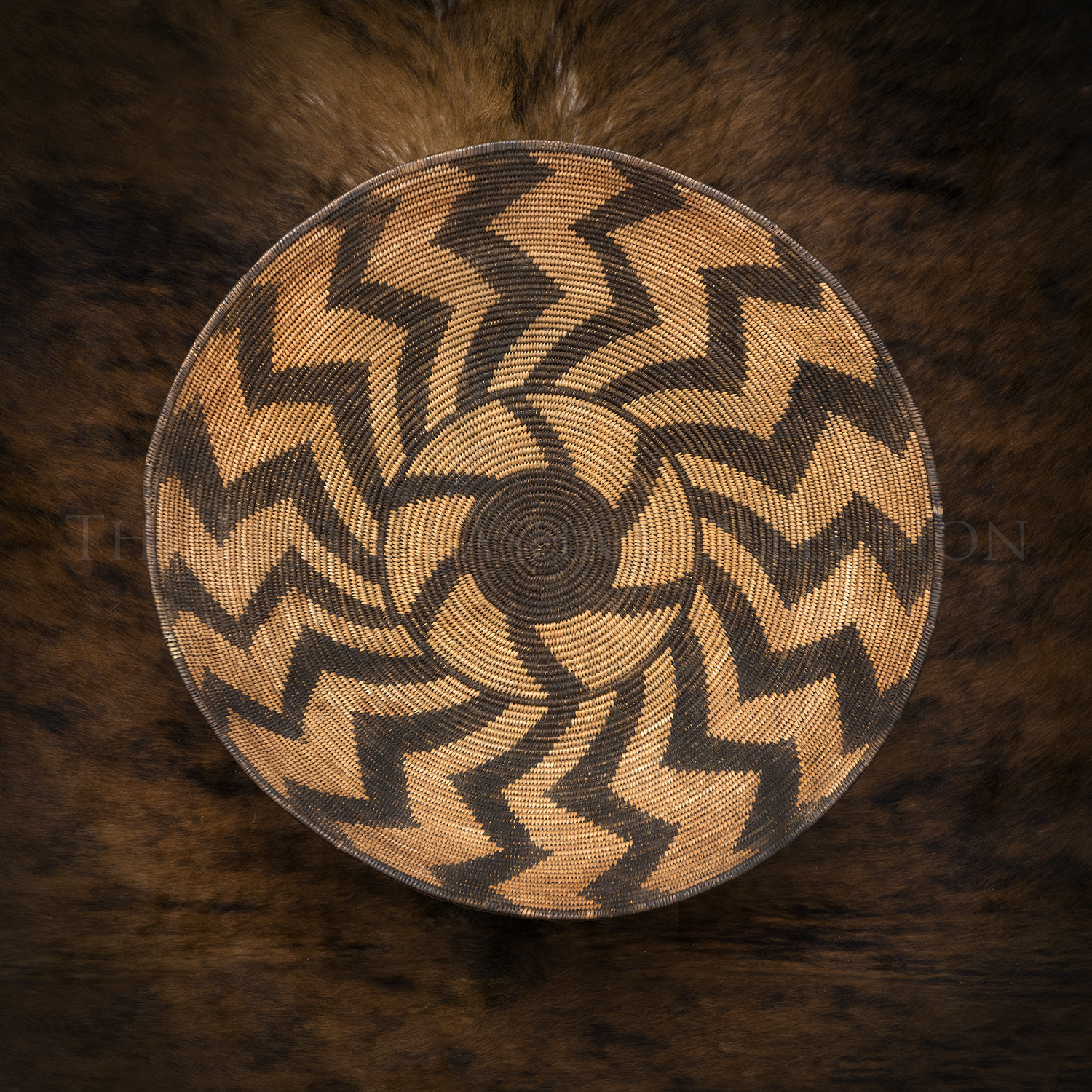
Apache Bowl (San Carlos) | Unknown Weaver
Artist: Apache
Description: Willow & Devil’s Claw over Three-Rod Foundation (Circa 1885-1895) | Dimensions: 21”baskets
The circle is a sacred symbol of the Apache and is representative of life while zig zags symbolize the various stages of life; both are depicted in this 21” bowl, circa 1885-1895. It is woven with willow and devil’s claw over a three-rod foundation.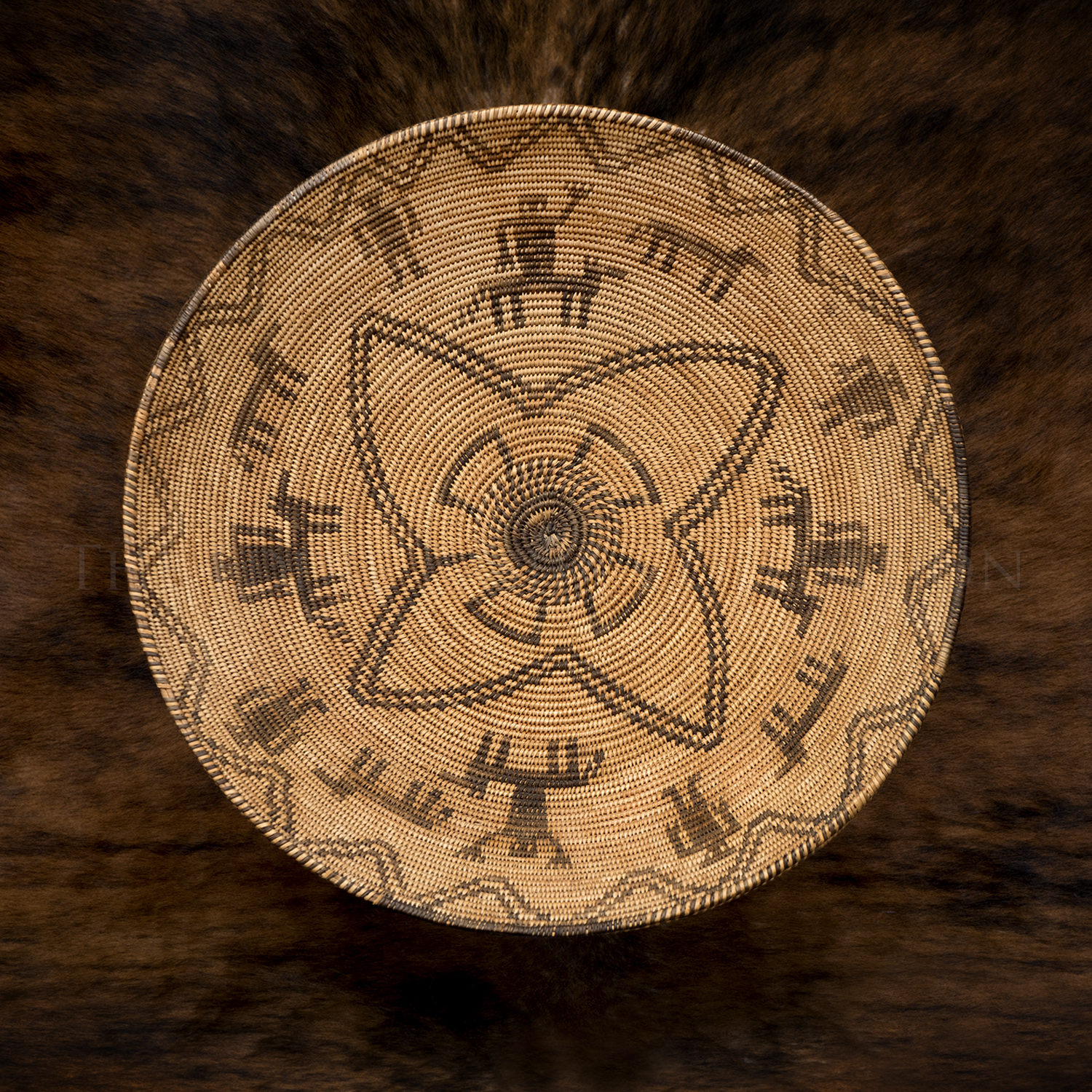
Apache Tray | Unknown Weaver
Artist: Apache
Description: Willow & Devil’s Claw over 3-Rod Foundation (Circa 1900) | 15” Diameterbaskets
Showing a four-part star in the center with four men horseback followed by four alternating individual men and horses this Apache Tray, circa 1900, has a 15” diameter and is completed with a double-terraced zigzag rim woven with willow and devil’s claw.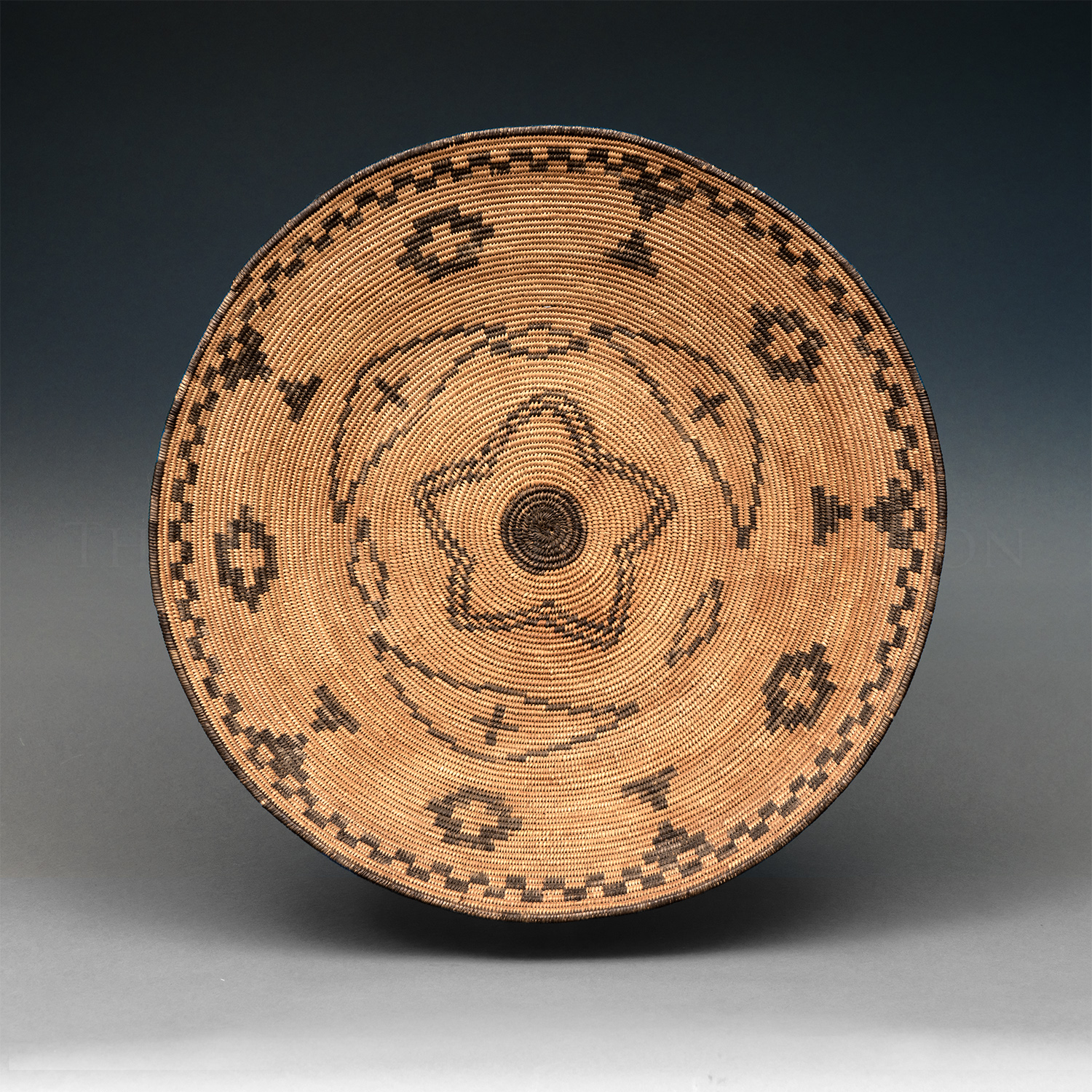
Apache Tray | Unknown Weaver
Artist: Apache
Description: Willow & Devil’s Claw over 3 Rod Foundation (Circa 1900) | 19 ½” Diameterbaskets
This 19 ½” diameter Apache Tray, circa 1900, features a five-pointed star encircled by three terraced triangles showing crosses inside. Additional small crosses and triangles appear beneath the stepped outside perimeter.
Baskets such as this Apache Tray along with countless others expertly woven by American Indian tribal members are celebrated for their cultural and historical significance.
Apache Tray | Unknown Weaver
Artist: Apache
Description: Willow, devil’s claw and yucca (Circa 1930) | Diameter: 14 ½”baskets
This 14 ½” Apache tray woven with willow, devil’s claw and yucca over a three-rod foundation exhibits a seven-pointed expanding star bordered by eighteen men and deer around the perimeter.
It never ceases to amaze that the early basket weavers developed these intricate patterns without the aid of a computer or any other electronic devices. Typically they learned by watching and listening to others within their own family or community. Though woven for utilitarian purposes initially such as the grains that were stored in them, the water or cactus fruit wines served from them, the games played on them, it’s the stories that were woven in them that offer insight into the lives of the talented weavers who made them. The EBC is honored and privileged to share these extraordinary weavings of the Apache, Pima, Yavapai, Navajo, Hopi, Havasupai, Chemehuevi, Hualapai, Papago, and Panamint American Indian Tribes.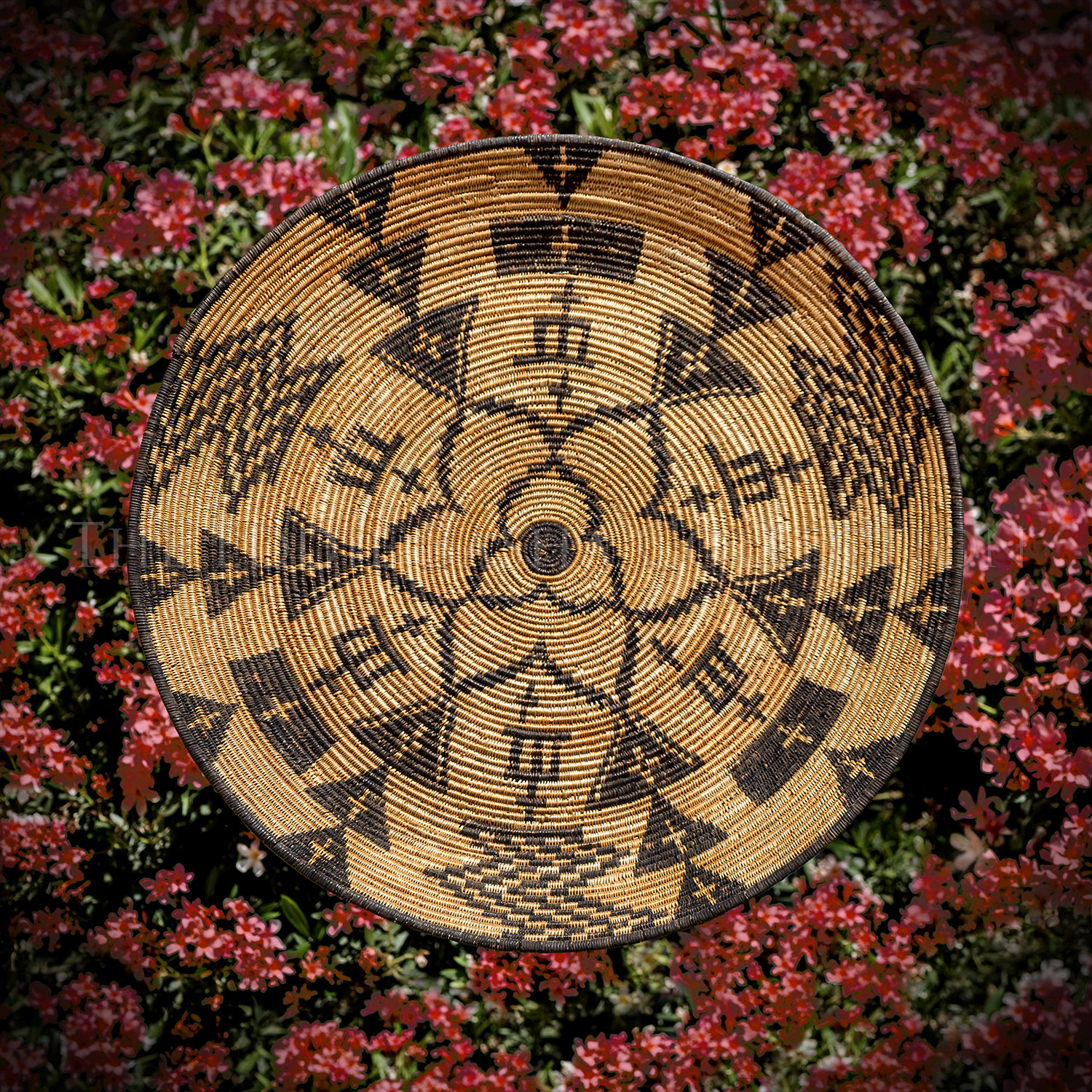
Apache Tray | Unknown Weaver
Artist: Apache
Description: Willow, devil’s claw over three-rod foundation (Circa 1920) | Dimensions: 26” Diameterbaskets
This 26” diameter Apache Tray woven with willow and devil’s claw over a three-rod foundation reveals a three to six-point star that pitches rows of alternating stacked triangles and rectangles featuring crosses, the symbol for spider woman who provided many first nations with the necessary survival skills to create tangible assets such as the ability to weave and to plant and grow crops. The tray is balanced by lightning bolts, the zigzagging, at its rim.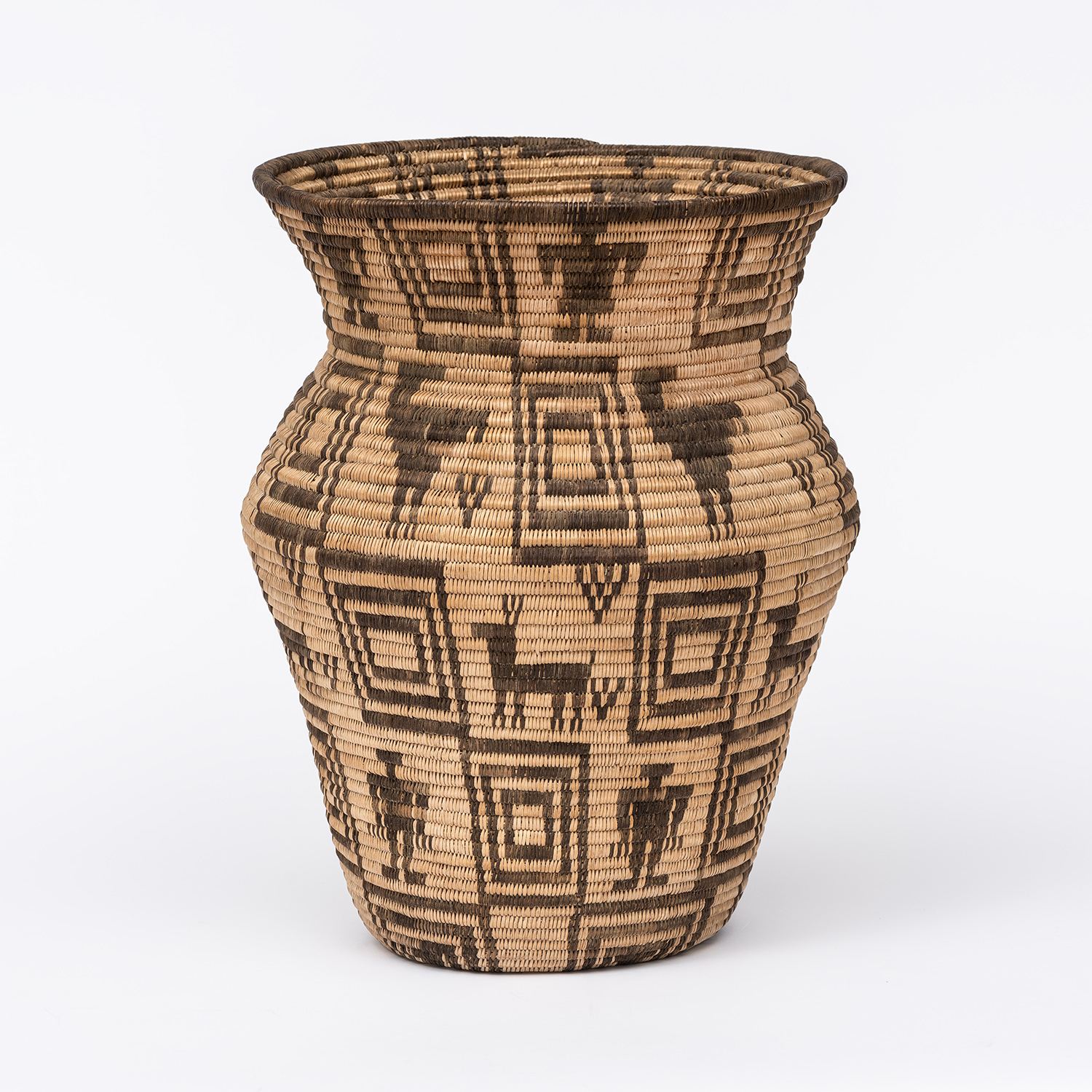
Apache Olla
Artist: Apache
Description: Willow, devil’s claw, over three-rod foundation (Circa 1920) | Dimensions: 14”h x 11”wbaskets
This Apache Olla, circa 1920, stands 14”h x 11”w. It is woven with willow and devil’s claw over a three-rod foundation and presents with diagonally-terraced, outlined squares with men, deer, birds and women placed above the squares which appear to be progressing toward the rim.
Apache Olla | Unknown Weaver
Artist: Apache
Description: Willow and devil’s claw over a three-rod foundation (Circa 1900) | Dimensions: 11”h x 10”wbaskets
This Apache Olla is approximately 11”h x 10”w with five rows of horizontal triangles in a deep, rich brown with aniline red diamonds outlined in that same deep, rich brown spaced between. A busy lightning pattern is on the base. It has a very fine stitch count and is woven with willow and devil’s claw over a three-rod foundation.
Aniline dye was introduced to the Indian population by European traders during the 1860’s. The dyes provided not only a broader pallet than what could be produced naturally, but they also delivered a vibrancy and intensity which was not previously possible. Over time some of the earlier produced dyes that were used began to fade. Today’s dyes have a much longer shelf life when cared for properly.
Apache Polychrome Tray
Artist: Apache
Description: Willow, devil’s claw & yucca (c. 1890) | Dimensions: 18” Diameterbaskets
A striking 18”, circa 1890, Apache polychrome geometric-patterned tray showing ten sets of diagonally linked rectangles spinning toward the rim in a clockwise direction. Each set alternates with black and red borders; each black rectangle shows a ticked red interior and vice versa. The weaver also artistically created a counter-clockwise fretted design at the base that balances the pinwheel effect of the overall theme. Willow, devil’s claw, and yucca over a three-rod foundation.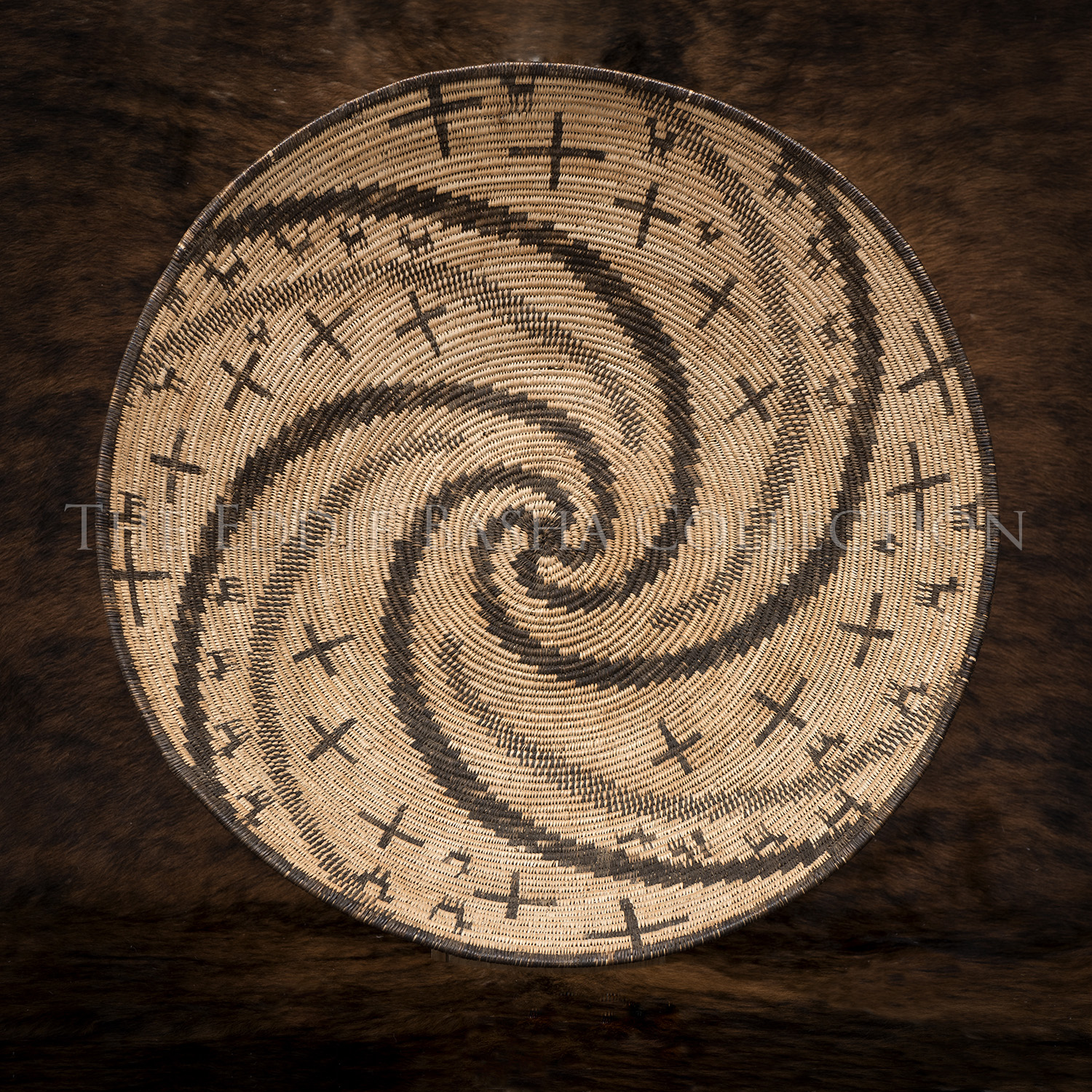
Apache Tray
Artist: Apache
Description: Willow & Devil’s Claw | Dimensions: 22”baskets
This 22” San Carlos Apache Tray displays a unique swirling pattern which resembles a whirlpool woven of devil’s claw and balanced with partial swirls done in ticking. It includes crosses, dogs, birds, and one human figure clustered between the swirls. Willow, devil’s claw over three-rod foundation.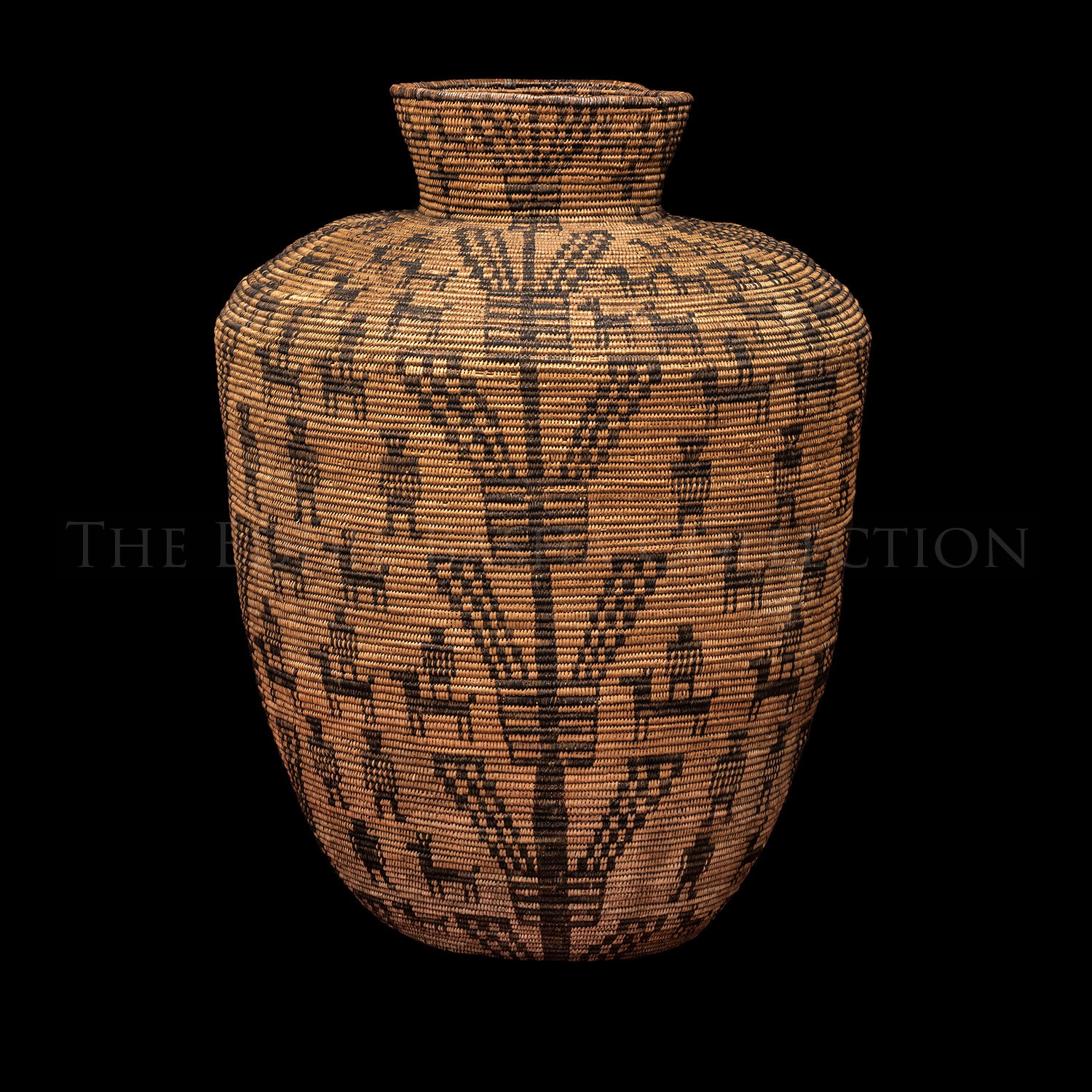
Apache Olla | Unknown Artist
Artist: Apache
Description: Willow & Devil’s Claw (Circa 1890) | Dimensions: 25”h x 21”wbaskets
This colossal Apache Olla basket, circa 1890, is split into four quadrants by stylized tree of life elements with multiple horizontal rows of human, dog and deer figures. Two of the rows show humans standing on large dogs or horses. Four crosses are placed around the mouth. It was woven with willow and devil’s claw over a three-rod foundation.
San Carlos Apache Tray
Artist: Apache
Description: Basket (c.1910) | Dimensions: 14 ¾” Diameterbaskets
In this San Carlos Apache Tray, circa 1910, there are five black whirlwind swirling elements imparting a dynamic sense of motion. In the willow field, five separate coyote tracks outline the terraced devil’s claw swirling elements. Willow, devil’s claw over three-rod foundation.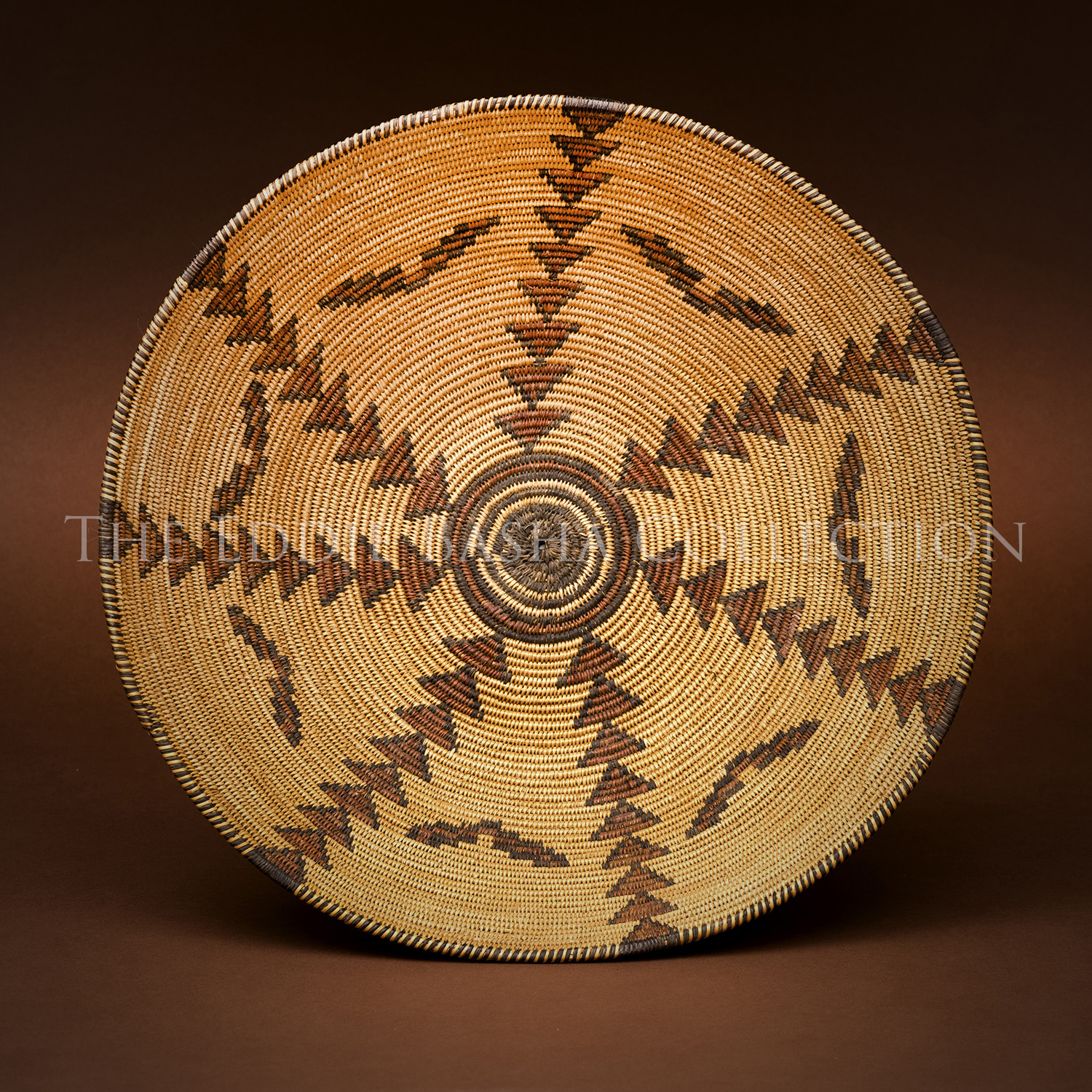
Apache Bowl
Artist: Apache
Description: Willow, Devil’s Claw & Yucca Root (Circa 1930) | Dimensions: 16”baskets
Enjoy this 16” polychrome Apache bowl, circa 1930, displaying seven rows of stacked triangles between seven elements that could be birds, butterflies or bees. There is ticking all around the rim. Most likely this basket is a White Mountain Apache bowl because of the abundance of red yucca root which is a higher growing plant than that which is encountered on the lower elevation of the San Carlos Reservation. It is woven with willow, devil’s claw and yucca root over a three-rod foundation.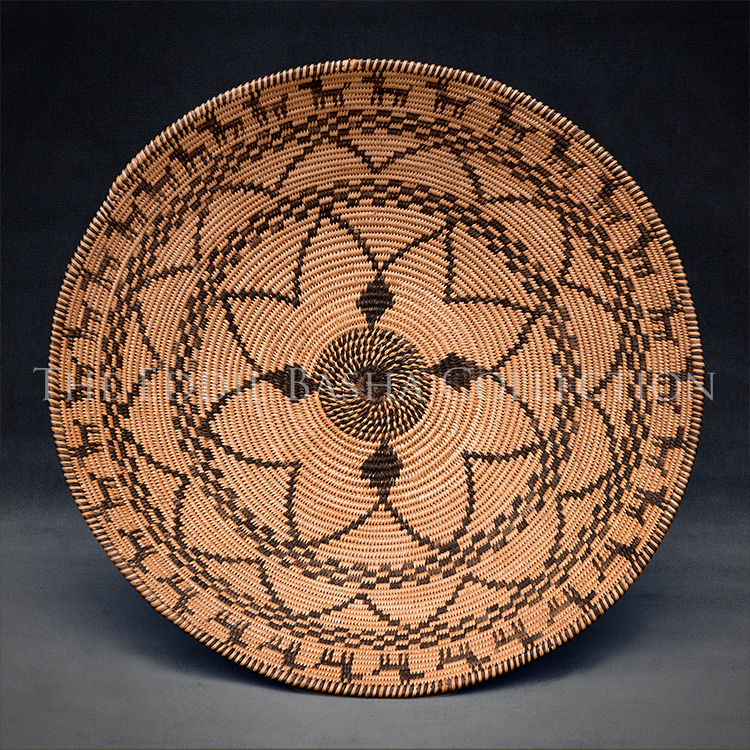
Apache Basket
Artist: Apache
Description: Willow and devil's claw; three-rod foundation (c.1900) | Dimensions: 16”baskets
This 16” Apache tray, circa 1900, features a delicate, eight-point star that expands into checkered elements, then a twelve-point star which also expands into checkered elements, and culminates with thirty-one dog figures at the rim. It is woven with willow and devil’s claw over a three-rod foundation.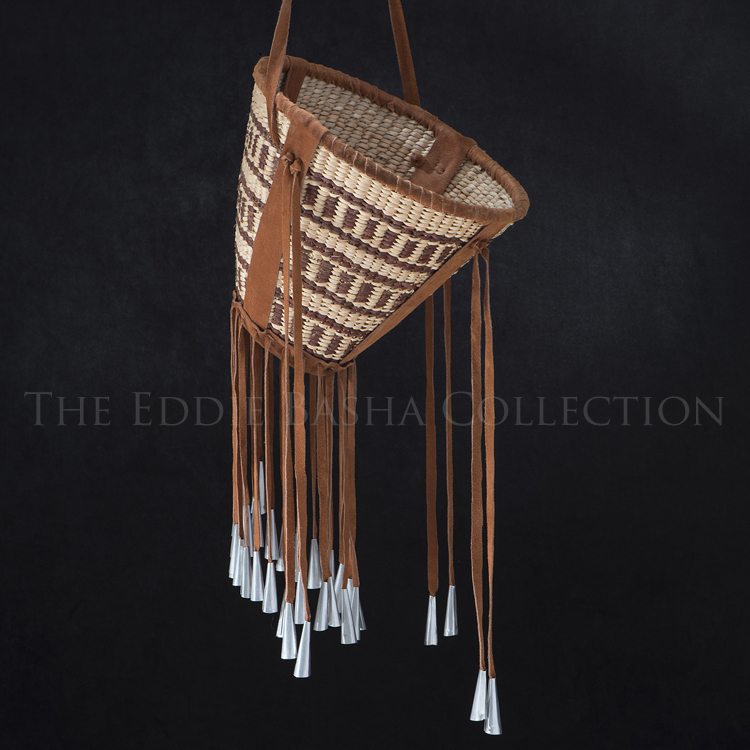
Apache Burden Basket
Artist: Apache
Description: Unknown Artistbaskets
Contemporary Apache Burden Baskets such as the one shown here are typically used for ceremonial or ornamental purposes. The tassels are often made from cow or deer hides and the tin, though now decorative, were once thought to ward off snakes while functioning as a utilitarian piece when foraging for food, cultivating crops, collecting firewood and even hauling water. And when male suitors were granted permission for a female’s hand in marriage by her mother, it is said that husband’s-to-be, alerted by the rattling of the tin cones, would know that he wasn’t to look at his future mother-in-law as an ultimate act of respect.
Apache Olla Basket
Artist: Apache
Description: In the foreground, this early Apache olla, circa 1880, presents with a prehistoric ceramic motif consisting of six horizontal zigzag bands against a black devil’s claw field that progresses toward the neck while the neck consists of checkered and cross elements. It was woven with willow and devil’s claw over a three-rod foundation. It measures 13 ½” x 13 ½”.baskets
The Apache olla behind, circa 1900, is a well-balanced basket both in design and form, starting with an eight-pointed star at the base and followed by a heavily terraced diagonal motif going from left to right and from the base to the rim. Two rows of spaced coyote tracks grace the shoulder. It too was woven with willow and devil’s claw over a three-rod foundation. It stands 20 ½”h and has an 18” diameter.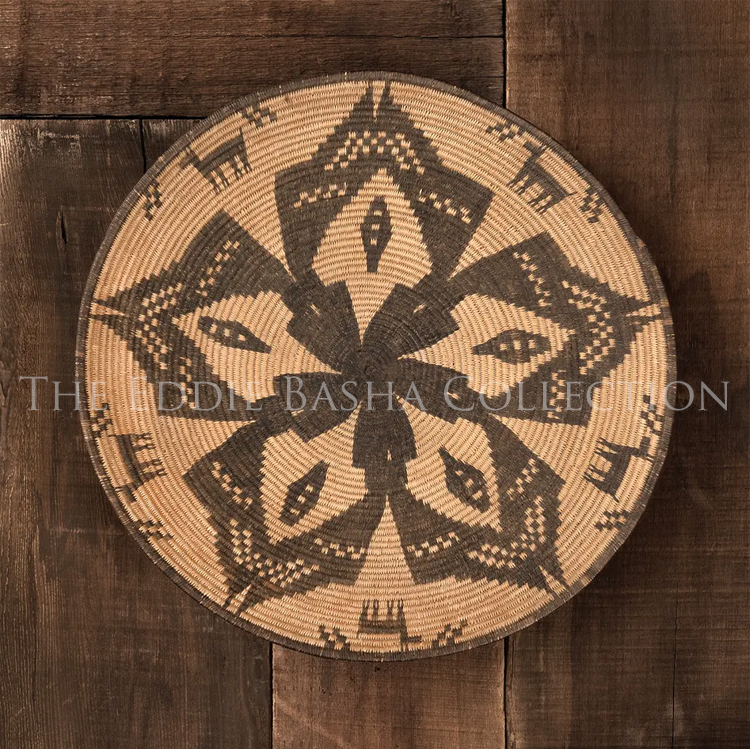
Apache Tray
Artist: Apache
Description: (Circa 1920) | 18” Diameterbaskets
This 18” Apache Tray, circa 1920, features an elaborate unfolding of a five-pointed star done in devil’s claw at its base, then willow and again outlined in devil’s claw which formed the illusion of stylized arrowheads inside the black field. Fine checkered elements add to the basket’s appeal as do the sharp double tips at the end of the five petals. Five deer balance the motif at the rim. This tray was woven over a three-rod foundation.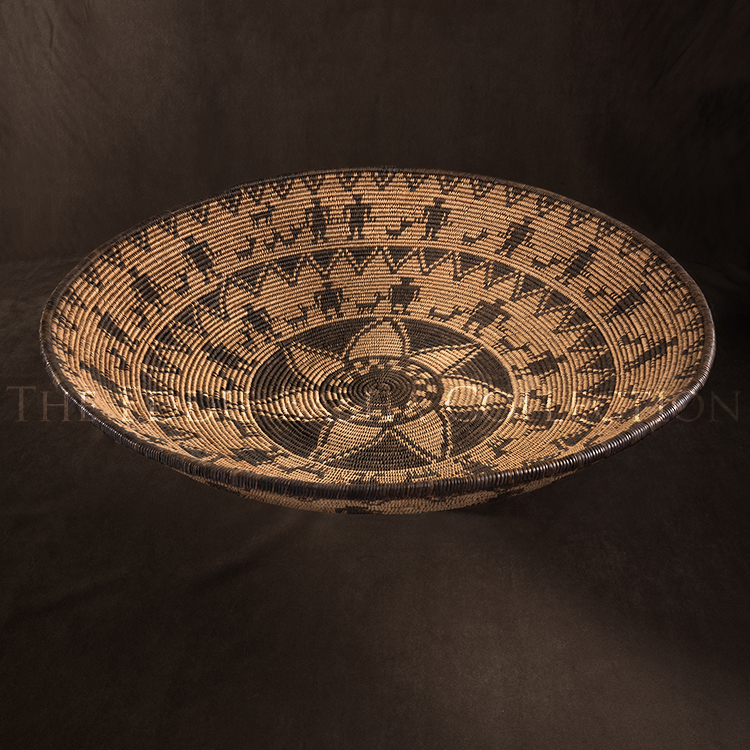
Apache Tray
Artist: Apache
Description: Willow & Devil’s Claw (Circa 1920) | Dimensions: 21 3/8” diameter x 4 ¾” deepbaskets
If you haven’t visited, the Native American Basket collection alone is certain to delight and amaze you with its quality and depth. There are over 350 baskets on display at any given time.
This selection spans 21 3/8” across and 4 ¾” deep. This Apache tray, circa 1920’s, begins with a seven-pointed star at its base and eleven pairs of human figures and dogs circle the star. Seventeen additional human figures and over twenty dogs complete the rim. It is woven with willow and devil’s claw over a three-rod foundation.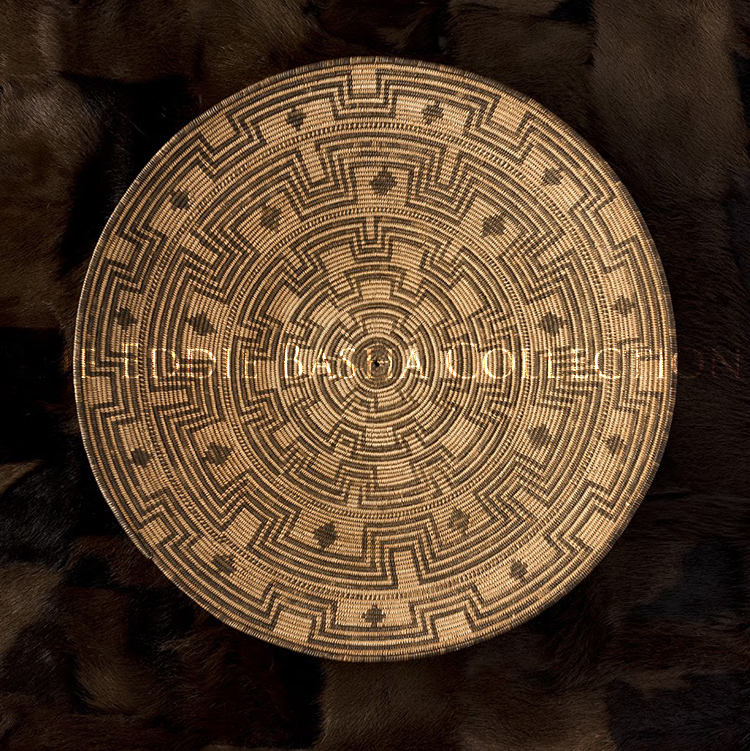
Apache Tray
Artist: Apache
Description: Basket (Circa 1890) | 19” Diameterbaskets
Woven with willow and devil’s claw over a three-rod foundation, this magnificent geometrically terraced Apache tray is very finely woven, especially for its size. Five rows form a maze-like pattern and the final two rows below the rim have diamonds placed between the terraces.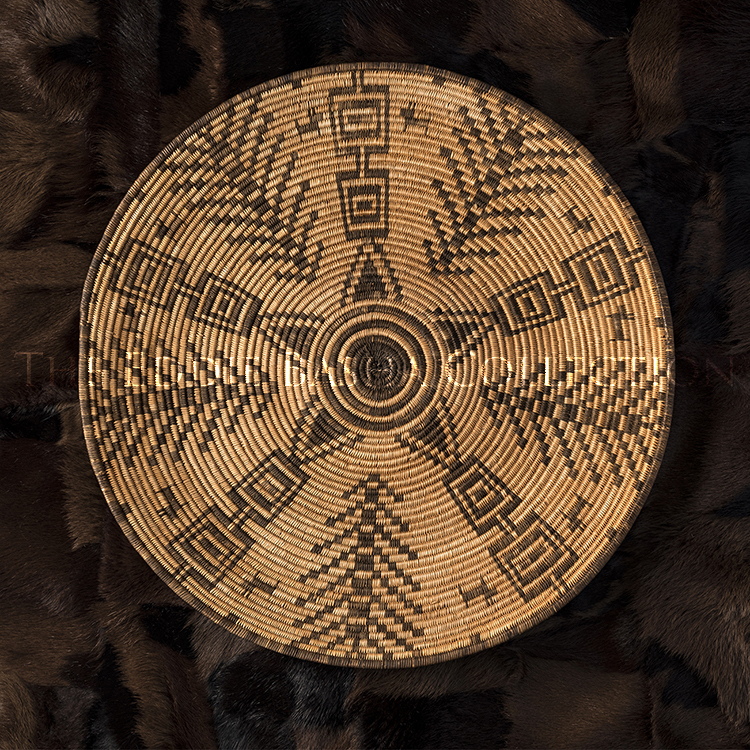
Apache Tray
Artist: Apache
Description: Basket (Circa 1900) | 20” Diameterbaskets
This Apache tray was woven with willow and devil’s claw over a three-rod foundation. A five-pointed star divides vertical botanical elements, possibly cornstalks, upward to the rim. These unique designs also resemble feathers. Above the points on the star are two vertical squares with a pair of dogs to the left and right of the higher square just below the rim.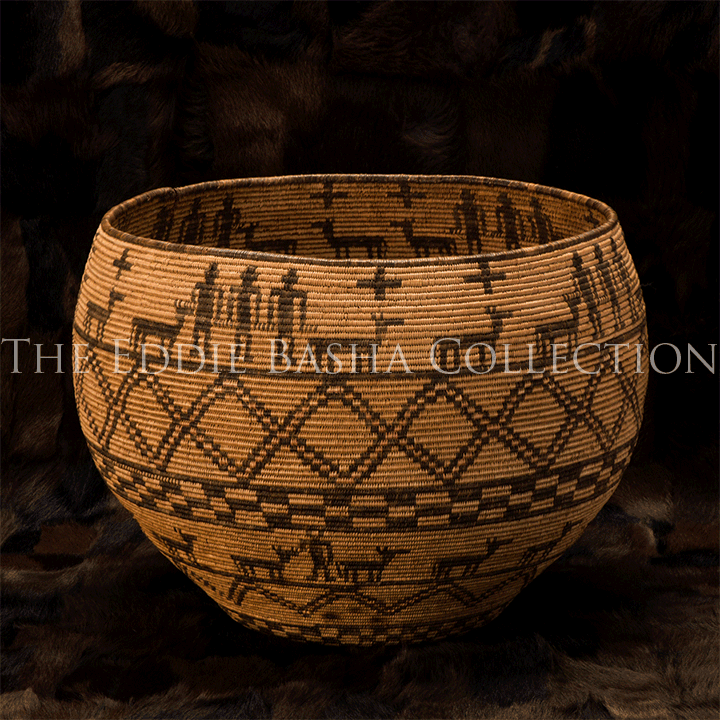
Apache Bowl
Artist: Apache
Description: (1900) | 15”d x 19.5”wbaskets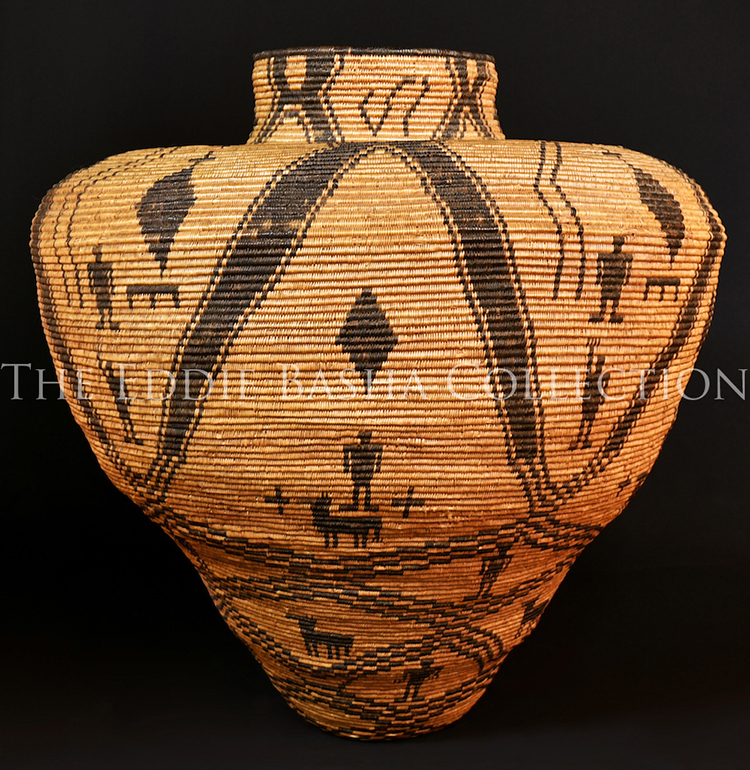
Apache Olla Basket
Artist: Apache
Description: (1885) | The basket starts with a five-pointed star at the base and forms diamonds with men and horses within. A third of the way up from the basket base, the field becomes more open and within the five massive black diamonds there are men, horses, crosses and various geometric elements. More crosses and random diagonal lines decorate the mouth. Willow, devil’s claw, over three-rod foundation.baskets
This large Apache Olla Basket displayed was once gifted to one of Arizona’s most notable female pioneers, Cordelia Crawford. The story has been told many times and as we understand it, Cordelia was somewhat of a pediatrician. This fact became well known throughout the region. In as much as Cordelia and her family settled in the area just outside of present day Globe, the Apache women would lay their sick children in front of Cordelia’s home. She would take them in, nurse them to good health and place them back outside once they were well enough to return. During that time as Apache raiding parties would traverse the eastern part of Arizona, the Crawford Ranch was never breached in deference to her.
At some point, Cordelia acquired this beautiful Apache basket and it had remained in the Crawford family and was passed on for many years. It wasn’t until very recent, the later part of the 1990’s, did that basket become available for sale. Not only are we proud to share the history of this particular Olla Basket with you, but subsequently we have come to find out that the wife of one of our company’s vice presidents is a descendant of Cordelia’s. It’s a small world after all. She, too, has a basket or two in her home and promises to one day share another part of her family’s legacy with all of us. We impatiently await that time.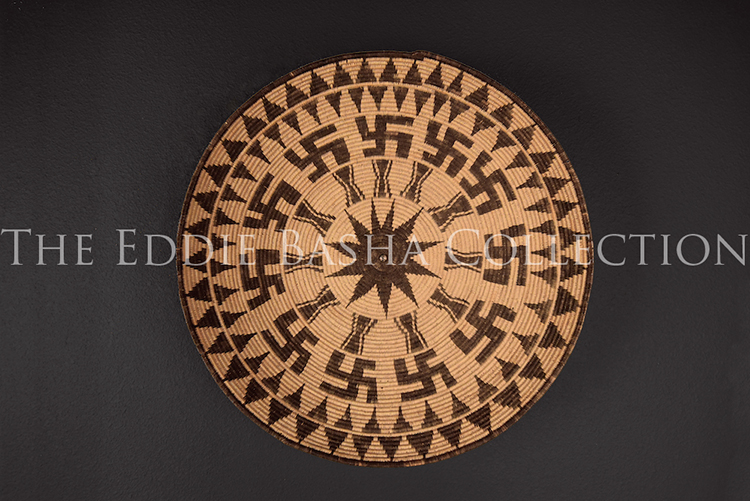
The Whirling Logs
Artist: Apache
Description: (1920) | Eleven-pointed star in center is supporting eleven hour-glass elements and eleven whirling logs with a feather motif at the rim. Willow, devil’s claw over three-rod foundation.baskets
When the first Navajo man and woman emerged from the underworld called The Third World, a water world, they bore a son. A few years later, the son was so intrigued about the stories he had heard about the underworld that he went back to the place of emergence and while looking down fell in. His father then went after him to rescue his son among the endless rivers of the underworld. After uniting there, they were thrown into the classic ancient legend, similar to the Illiad and Odyssey, where on their long and perilous journey they experienced and learned the heritage and lessons of Navajo medicine, which all had originated there. At the completion of their journey, harboring all of this valuable knowledge, they were attempting to exit the underworld when they were attacked by The Water Monsters. Just as the father and son were about to perish, two logs formed a cross in the water and four Yeis (holy messengers) appeared at the tips of the logs, forming a swastika-like shape. The Yeis promised to save them if the father and son would get on to the logs and believe in them, giving the Yeis their full confidence and faith. The father and son agreed and the Yeis whirled them back to the present world and safety. Thus, the Whirling Logs became the symbol that to this day is cherished as a reminder of the link that preserves their sacred medicine and traditions. The Navajo were forbidden to incorporate this symbol on their art during the 1930s because of Nazi Germany, but it is still seen in the traditional sand paintings that are used to cure their people during the Yei-Be-Chai healing ceremonies.
Whirling logs are seen in Apache, Yavapai, Hopi, Havasupai, Chemehuevi, Pima and Tohono O’odham baskets as well as in various Great Basin and California basketry. Here they take on the concept of the four cardinal directions, as well as a depiction of one complete lifespan, or generation: the four points of the symbol representing birth, youth, old age and death. As seen in examples here in the gallery, some Pima weavers artistically linked several of the whirling logs together in continuous circular patterns, thus binding one generation to another both in the past and future. This motif was sacred to many Native Americans throughout the Americas.
Hopefully this information will answer the question about the use of the symbol and release the stigma associated with it. Not only have Native Americans utilized it in their culture, but so have the Hindus, Buddhists, Chinese, early Egyptians, Phoenicians, Etruscans, Greeks and Romans, long before it was stigmatized by its use in such a negative fashion.
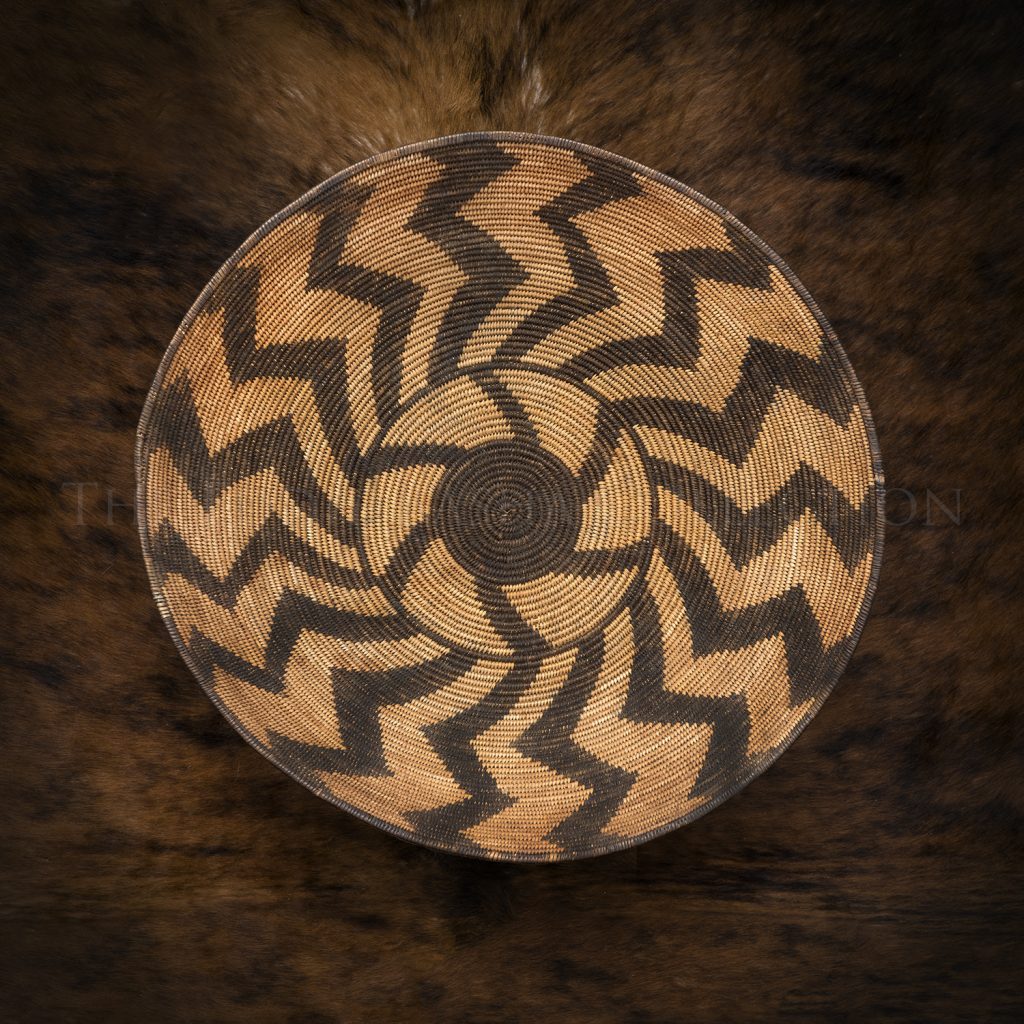 Willow & Devil’s Claw over Three-Rod Foundation (Circa 1885-1895) | Dimensions: 21”
Willow & Devil’s Claw over Three-Rod Foundation (Circa 1885-1895) | Dimensions: 21”The circle is a sacred symbol of the Apache and is representative of life while zig zags symbolize the various stages of life; both are depicted in this 21” bowl, circa 1885-1895. It is woven with willow and devil’s claw over a three-rod foundation.
Apache Bowl (San Carlos) | Unknown Weaver
Artist: Apache
Description:
Willow & Devil’s Claw over Three-Rod Foundation (Circa 1885-1895) | Dimensions: 21”
The circle is a sacred symbol of the Apache and is representative of life while zig zags symbolize the various stages of life; both are depicted in this 21” bowl, circa 1885-1895. It is woven with willow and devil’s claw over a three-rod foundation.
basketsThe circle is a sacred symbol of the Apache and is representative of life while zig zags symbolize the various stages of life; both are depicted in this 21” bowl, circa 1885-1895. It is woven with willow and devil’s claw over a three-rod foundation.
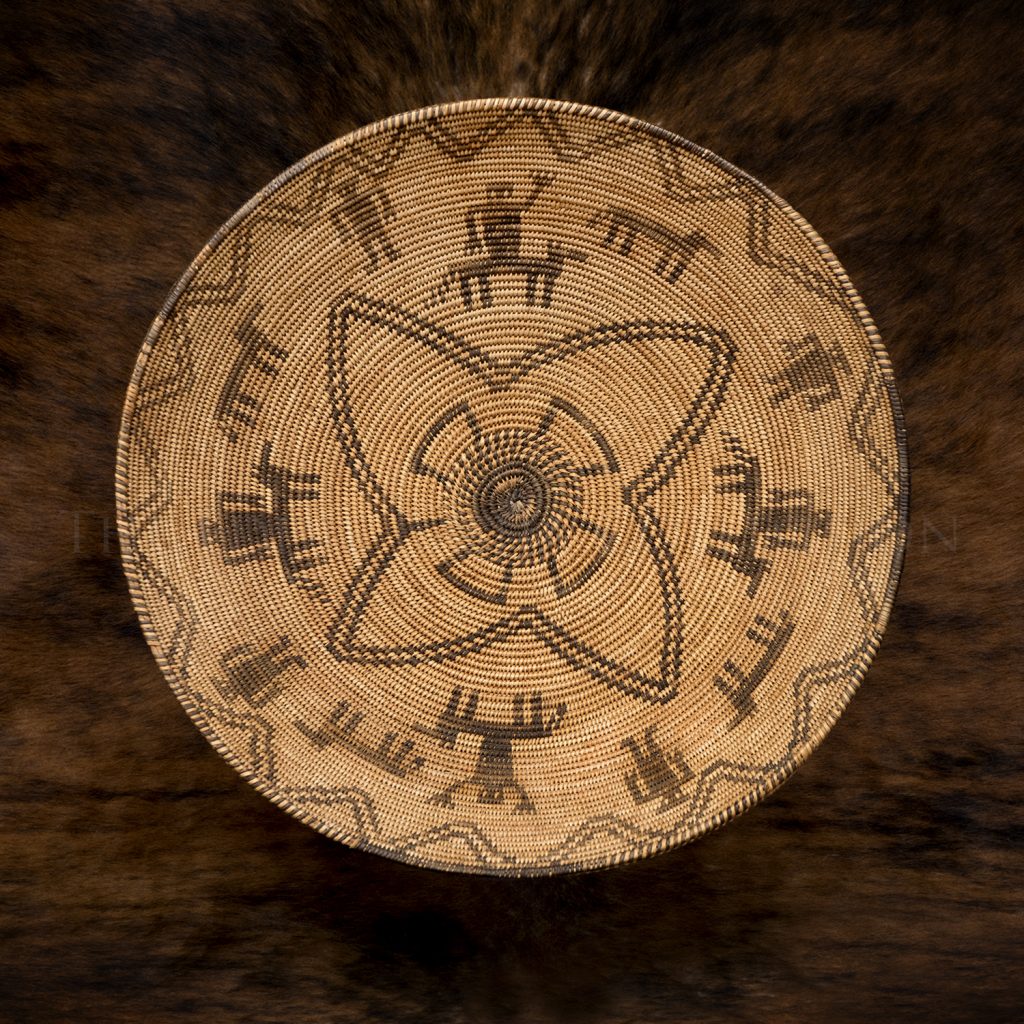 Willow & Devil’s Claw over 3-Rod Foundation (Circa 1900) | 15” Diameter
Willow & Devil’s Claw over 3-Rod Foundation (Circa 1900) | 15” DiameterShowing a four-part star in the center with four men horseback followed by four alternating individual men and horses this Apache Tray, circa 1900, has a 15” diameter and is completed with a double-terraced zigzag rim woven with willow and devil’s claw.
Apache Tray | Unknown Weaver
Artist: Apache
Description:
Willow & Devil’s Claw over 3-Rod Foundation (Circa 1900) | 15” Diameter
Showing a four-part star in the center with four men horseback followed by four alternating individual men and horses this Apache Tray, circa 1900, has a 15” diameter and is completed with a double-terraced zigzag rim woven with willow and devil’s claw.
basketsShowing a four-part star in the center with four men horseback followed by four alternating individual men and horses this Apache Tray, circa 1900, has a 15” diameter and is completed with a double-terraced zigzag rim woven with willow and devil’s claw.
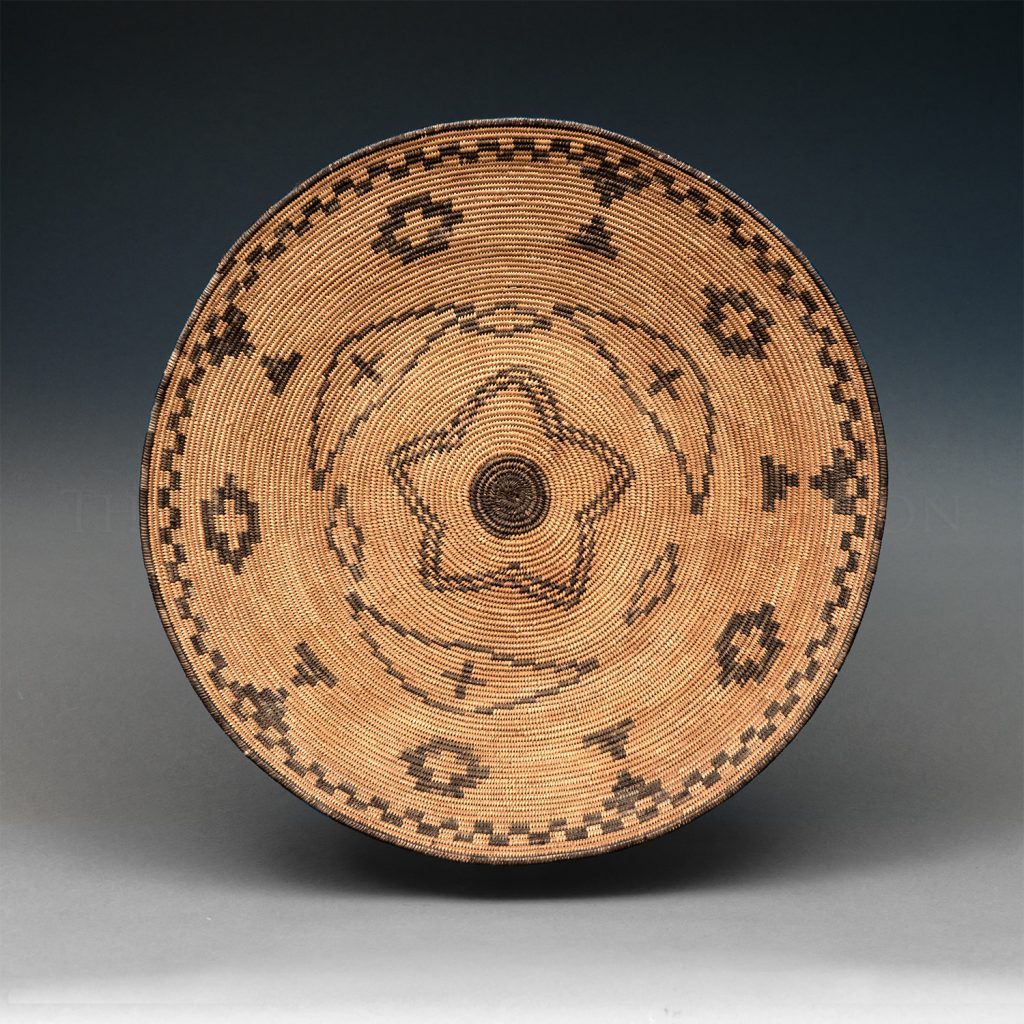 Willow & Devil’s Claw over 3 Rod Foundation (Circa 1900) | 19 ½” Diameter
Willow & Devil’s Claw over 3 Rod Foundation (Circa 1900) | 19 ½” Diameter This 19 ½” diameter Apache Tray, circa 1900, features a five-pointed star encircled by three terraced triangles showing crosses inside. Additional small crosses and triangles appear beneath the stepped outside perimeter.
Baskets such as this Apache Tray along with countless others expertly woven by American Indian tribal members are celebrated for their cultural and historical significance.
Apache Tray | Unknown Weaver
Artist: Apache
Description:
Willow & Devil’s Claw over 3 Rod Foundation (Circa 1900) | 19 ½” Diameter
This 19 ½” diameter Apache Tray, circa 1900, features a five-pointed star encircled by three terraced triangles showing crosses inside. Additional small crosses and triangles appear beneath the stepped outside perimeter.
Baskets such as this Apache Tray along with countless others expertly woven by American Indian tribal members are celebrated for their cultural and historical significance.
basketsThis 19 ½” diameter Apache Tray, circa 1900, features a five-pointed star encircled by three terraced triangles showing crosses inside. Additional small crosses and triangles appear beneath the stepped outside perimeter.
Baskets such as this Apache Tray along with countless others expertly woven by American Indian tribal members are celebrated for their cultural and historical significance.
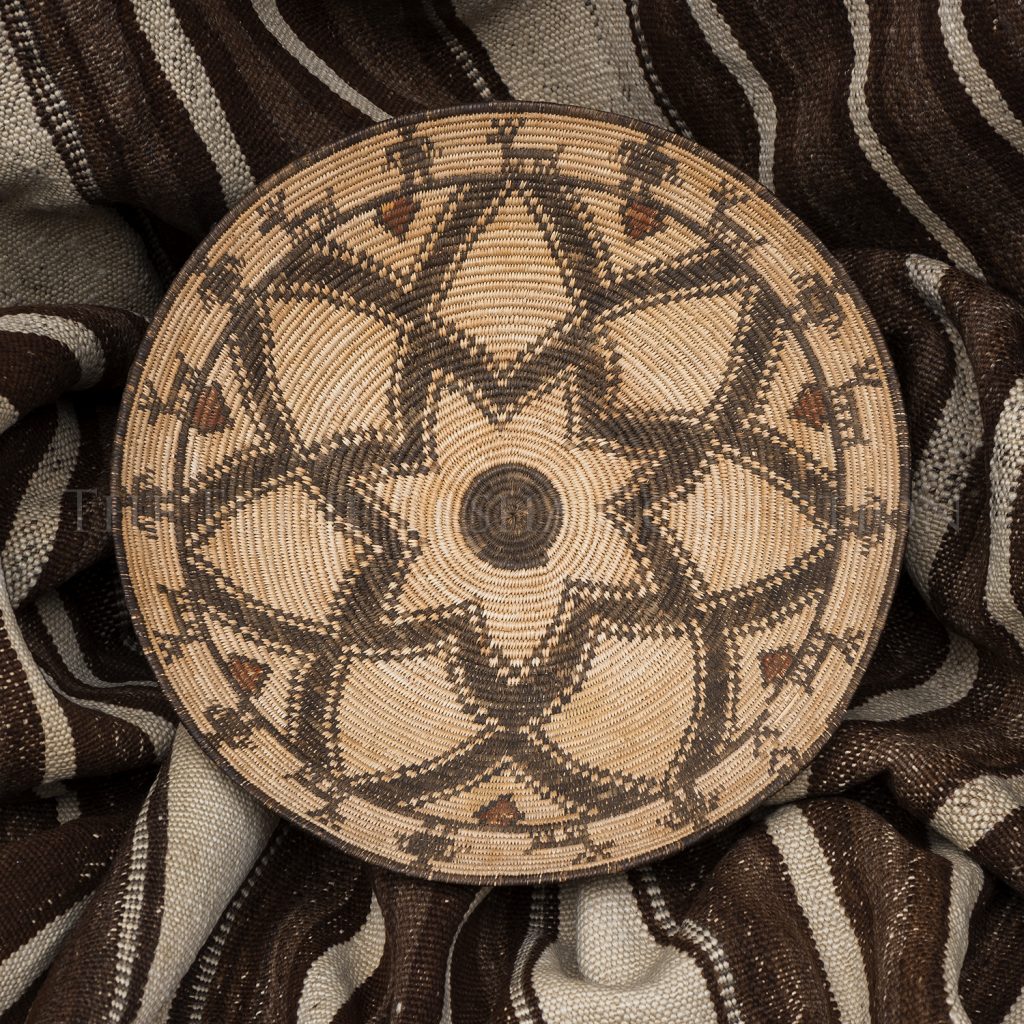 Willow, devil’s claw and yucca (Circa 1930) | Diameter: 14 ½”
Willow, devil’s claw and yucca (Circa 1930) | Diameter: 14 ½”This 14 ½” Apache tray woven with willow, devil’s claw and yucca over a three-rod foundation exhibits a seven-pointed expanding star bordered by eighteen men and deer around the perimeter.
It never ceases to amaze that the early basket weavers developed these intricate patterns without the aid of a computer or any other electronic devices. Typically they learned by watching and listening to others within their own family or community. Though woven for utilitarian purposes initially such as the grains that were stored in them, the water or cactus fruit wines served from them, the games played on them, it’s the stories that were woven in them that offer insight into the lives of the talented weavers who made them. The EBC is honored and privileged to share these extraordinary weavings of the Apache, Pima, Yavapai, Navajo, Hopi, Havasupai, Chemehuevi, Hualapai, Papago, and Panamint American Indian Tribes.
Apache Tray | Unknown Weaver
Artist: Apache
Description:
Willow, devil’s claw and yucca (Circa 1930) | Diameter: 14 ½”
This 14 ½” Apache tray woven with willow, devil’s claw and yucca over a three-rod foundation exhibits a seven-pointed expanding star bordered by eighteen men and deer around the perimeter.
It never ceases to amaze that the early basket weavers developed these intricate patterns without the aid of a computer or any other electronic devices. Typically they learned by watching and listening to others within their own family or community. Though woven for utilitarian purposes initially such as the grains that were stored in them, the water or cactus fruit wines served from them, the games played on them, it’s the stories that were woven in them that offer insight into the lives of the talented weavers who made them. The EBC is honored and privileged to share these extraordinary weavings of the Apache, Pima, Yavapai, Navajo, Hopi, Havasupai, Chemehuevi, Hualapai, Papago, and Panamint American Indian Tribes.
basketsThis 14 ½” Apache tray woven with willow, devil’s claw and yucca over a three-rod foundation exhibits a seven-pointed expanding star bordered by eighteen men and deer around the perimeter.
It never ceases to amaze that the early basket weavers developed these intricate patterns without the aid of a computer or any other electronic devices. Typically they learned by watching and listening to others within their own family or community. Though woven for utilitarian purposes initially such as the grains that were stored in them, the water or cactus fruit wines served from them, the games played on them, it’s the stories that were woven in them that offer insight into the lives of the talented weavers who made them. The EBC is honored and privileged to share these extraordinary weavings of the Apache, Pima, Yavapai, Navajo, Hopi, Havasupai, Chemehuevi, Hualapai, Papago, and Panamint American Indian Tribes.
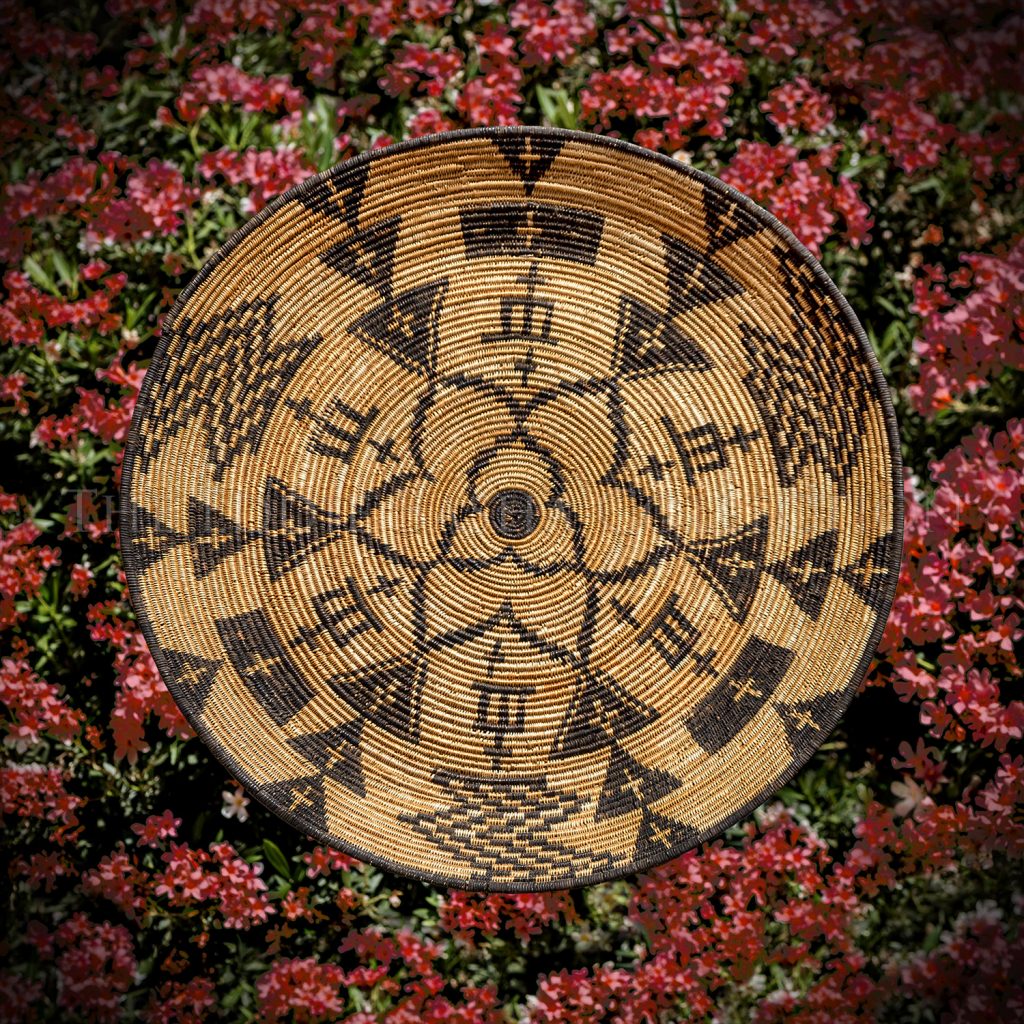 Willow, devil’s claw over three-rod foundation (Circa 1920) | Dimensions: 26” Diameter
Willow, devil’s claw over three-rod foundation (Circa 1920) | Dimensions: 26” DiameterThis 26” diameter Apache Tray woven with willow and devil’s claw over a three-rod foundation reveals a three to six-point star that pitches rows of alternating stacked triangles and rectangles featuring crosses, the symbol for spider woman who provided many first nations with the necessary survival skills to create tangible assets such as the ability to weave and to plant and grow crops. The tray is balanced by lightning bolts, the zigzagging, at its rim.
Apache Tray | Unknown Weaver
Artist: Apache
Description:
Willow, devil’s claw over three-rod foundation (Circa 1920) | Dimensions: 26” Diameter
This 26” diameter Apache Tray woven with willow and devil’s claw over a three-rod foundation reveals a three to six-point star that pitches rows of alternating stacked triangles and rectangles featuring crosses, the symbol for spider woman who provided many first nations with the necessary survival skills to create tangible assets such as the ability to weave and to plant and grow crops. The tray is balanced by lightning bolts, the zigzagging, at its rim.
basketsThis 26” diameter Apache Tray woven with willow and devil’s claw over a three-rod foundation reveals a three to six-point star that pitches rows of alternating stacked triangles and rectangles featuring crosses, the symbol for spider woman who provided many first nations with the necessary survival skills to create tangible assets such as the ability to weave and to plant and grow crops. The tray is balanced by lightning bolts, the zigzagging, at its rim.
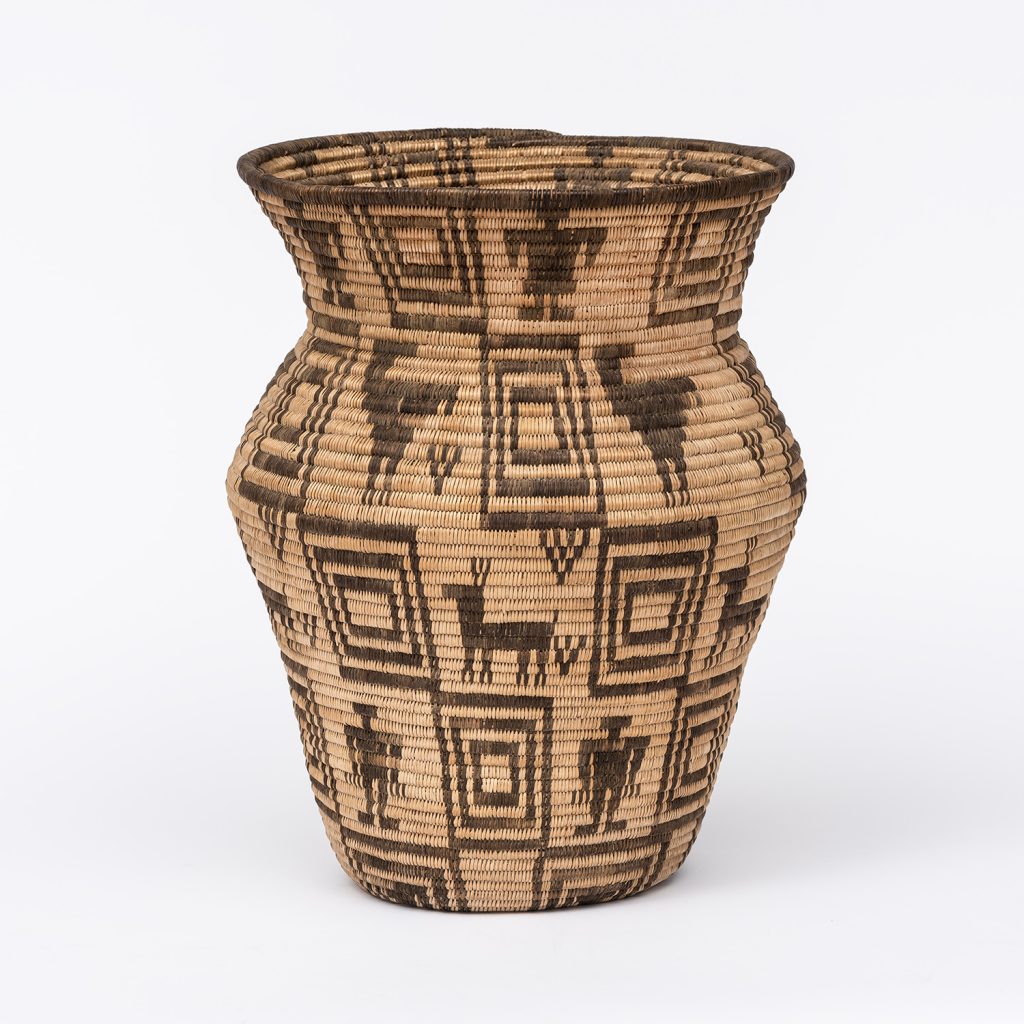 Willow, devil’s claw, over three-rod foundation (Circa 1920) | Dimensions: 14”h x 11”w
Willow, devil’s claw, over three-rod foundation (Circa 1920) | Dimensions: 14”h x 11”wThis Apache Olla, circa 1920, stands 14”h x 11”w. It is woven with willow and devil’s claw over a three-rod foundation and presents with diagonally-terraced, outlined squares with men, deer, birds and women placed above the squares which appear to be progressing toward the rim.
Apache Olla
Artist: Apache
Description:
Willow, devil’s claw, over three-rod foundation (Circa 1920) | Dimensions: 14”h x 11”w
This Apache Olla, circa 1920, stands 14”h x 11”w. It is woven with willow and devil’s claw over a three-rod foundation and presents with diagonally-terraced, outlined squares with men, deer, birds and women placed above the squares which appear to be progressing toward the rim.
basketsThis Apache Olla, circa 1920, stands 14”h x 11”w. It is woven with willow and devil’s claw over a three-rod foundation and presents with diagonally-terraced, outlined squares with men, deer, birds and women placed above the squares which appear to be progressing toward the rim.
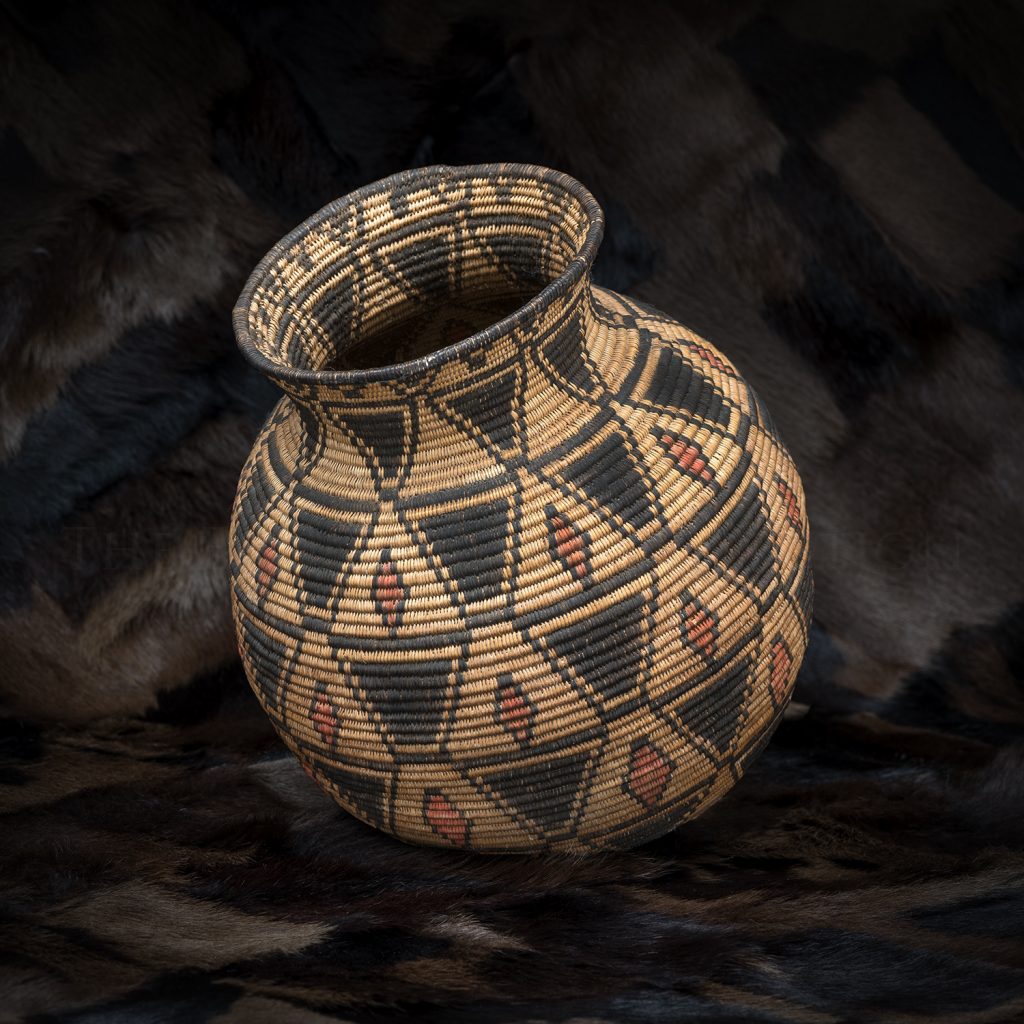 Willow and devil’s claw over a three-rod foundation (Circa 1900) | Dimensions: 11”h x 10”w
Willow and devil’s claw over a three-rod foundation (Circa 1900) | Dimensions: 11”h x 10”wThis Apache Olla is approximately 11”h x 10”w with five rows of horizontal triangles in a deep, rich brown with aniline red diamonds outlined in that same deep, rich brown spaced between. A busy lightning pattern is on the base. It has a very fine stitch count and is woven with willow and devil’s claw over a three-rod foundation.
Aniline dye was introduced to the Indian population by European traders during the 1860’s. The dyes provided not only a broader pallet than what could be produced naturally, but they also delivered a vibrancy and intensity which was not previously possible. Over time some of the earlier produced dyes that were used began to fade. Today’s dyes have a much longer shelf life when cared for properly.
Apache Olla | Unknown Weaver
Artist: Apache
Description:
Willow and devil’s claw over a three-rod foundation (Circa 1900) | Dimensions: 11”h x 10”w
This Apache Olla is approximately 11”h x 10”w with five rows of horizontal triangles in a deep, rich brown with aniline red diamonds outlined in that same deep, rich brown spaced between. A busy lightning pattern is on the base. It has a very fine stitch count and is woven with willow and devil’s claw over a three-rod foundation.
Aniline dye was introduced to the Indian population by European traders during the 1860’s. The dyes provided not only a broader pallet than what could be produced naturally, but they also delivered a vibrancy and intensity which was not previously possible. Over time some of the earlier produced dyes that were used began to fade. Today’s dyes have a much longer shelf life when cared for properly.
basketsThis Apache Olla is approximately 11”h x 10”w with five rows of horizontal triangles in a deep, rich brown with aniline red diamonds outlined in that same deep, rich brown spaced between. A busy lightning pattern is on the base. It has a very fine stitch count and is woven with willow and devil’s claw over a three-rod foundation.
Aniline dye was introduced to the Indian population by European traders during the 1860’s. The dyes provided not only a broader pallet than what could be produced naturally, but they also delivered a vibrancy and intensity which was not previously possible. Over time some of the earlier produced dyes that were used began to fade. Today’s dyes have a much longer shelf life when cared for properly.
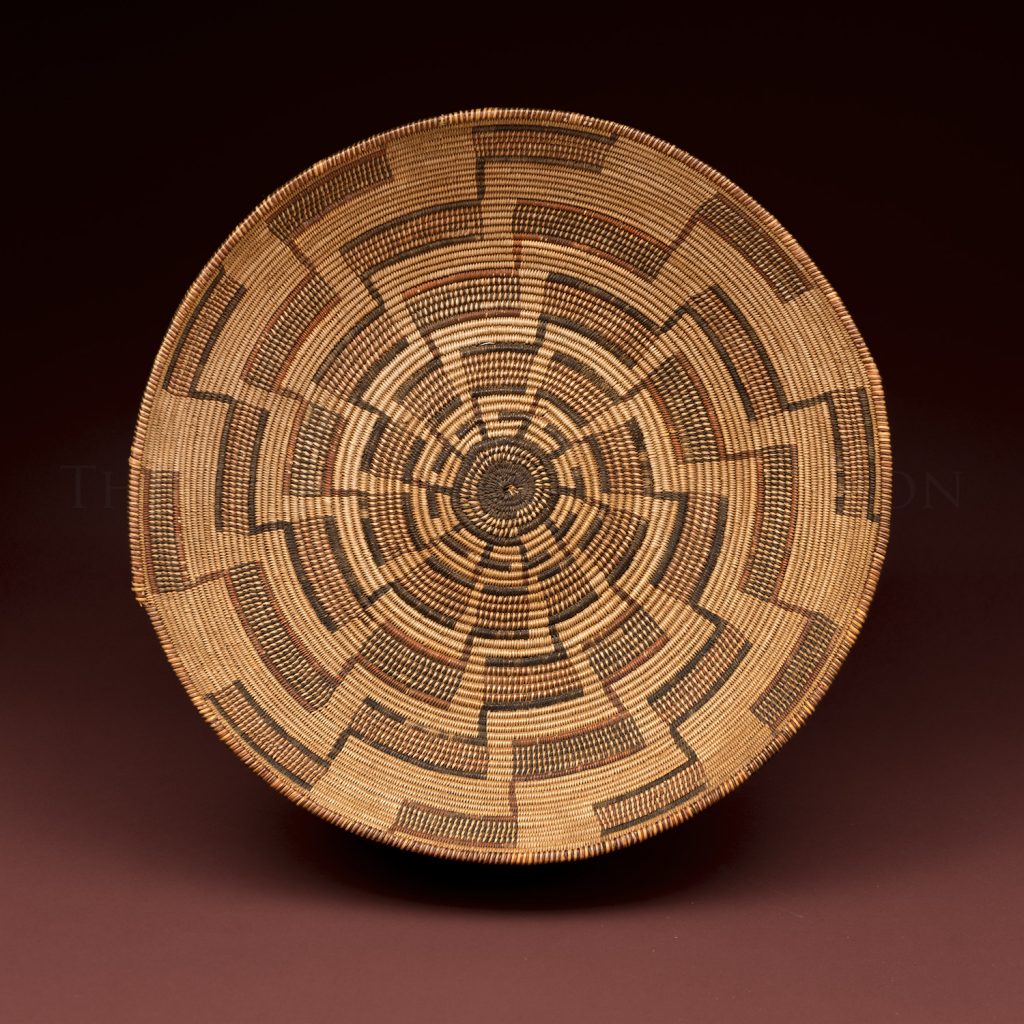 Willow, devil’s claw & yucca (c. 1890) | Dimensions: 18” Diameter
Willow, devil’s claw & yucca (c. 1890) | Dimensions: 18” DiameterA striking 18”, circa 1890, Apache polychrome geometric-patterned tray showing ten sets of diagonally linked rectangles spinning toward the rim in a clockwise direction. Each set alternates with black and red borders; each black rectangle shows a ticked red interior and vice versa. The weaver also artistically created a counter-clockwise fretted design at the base that balances the pinwheel effect of the overall theme. Willow, devil’s claw, and yucca over a three-rod foundation.
Apache Polychrome Tray
Artist: Apache
Description:
Willow, devil’s claw & yucca (c. 1890) | Dimensions: 18” Diameter
A striking 18”, circa 1890, Apache polychrome geometric-patterned tray showing ten sets of diagonally linked rectangles spinning toward the rim in a clockwise direction. Each set alternates with black and red borders; each black rectangle shows a ticked red interior and vice versa. The weaver also artistically created a counter-clockwise fretted design at the base that balances the pinwheel effect of the overall theme. Willow, devil’s claw, and yucca over a three-rod foundation.
basketsA striking 18”, circa 1890, Apache polychrome geometric-patterned tray showing ten sets of diagonally linked rectangles spinning toward the rim in a clockwise direction. Each set alternates with black and red borders; each black rectangle shows a ticked red interior and vice versa. The weaver also artistically created a counter-clockwise fretted design at the base that balances the pinwheel effect of the overall theme. Willow, devil’s claw, and yucca over a three-rod foundation.
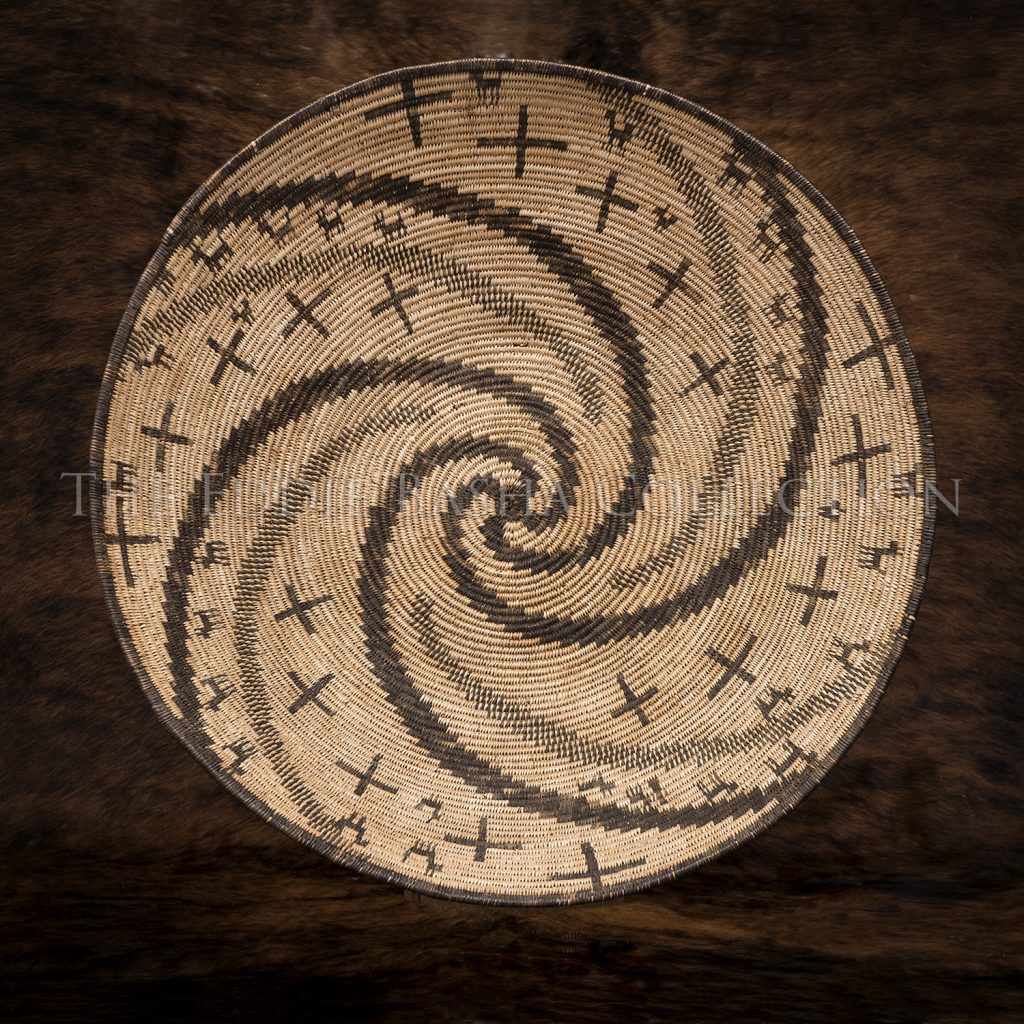 Willow & Devil’s Claw | Dimensions: 22”
Willow & Devil’s Claw | Dimensions: 22”This 22” San Carlos Apache Tray displays a unique swirling pattern which resembles a whirlpool woven of devil’s claw and balanced with partial swirls done in ticking. It includes crosses, dogs, birds, and one human figure clustered between the swirls. Willow, devil’s claw over three-rod foundation.
Apache Tray
Artist: Apache
Description:
Willow & Devil’s Claw | Dimensions: 22”
This 22” San Carlos Apache Tray displays a unique swirling pattern which resembles a whirlpool woven of devil’s claw and balanced with partial swirls done in ticking. It includes crosses, dogs, birds, and one human figure clustered between the swirls. Willow, devil’s claw over three-rod foundation.
basketsThis 22” San Carlos Apache Tray displays a unique swirling pattern which resembles a whirlpool woven of devil’s claw and balanced with partial swirls done in ticking. It includes crosses, dogs, birds, and one human figure clustered between the swirls. Willow, devil’s claw over three-rod foundation.
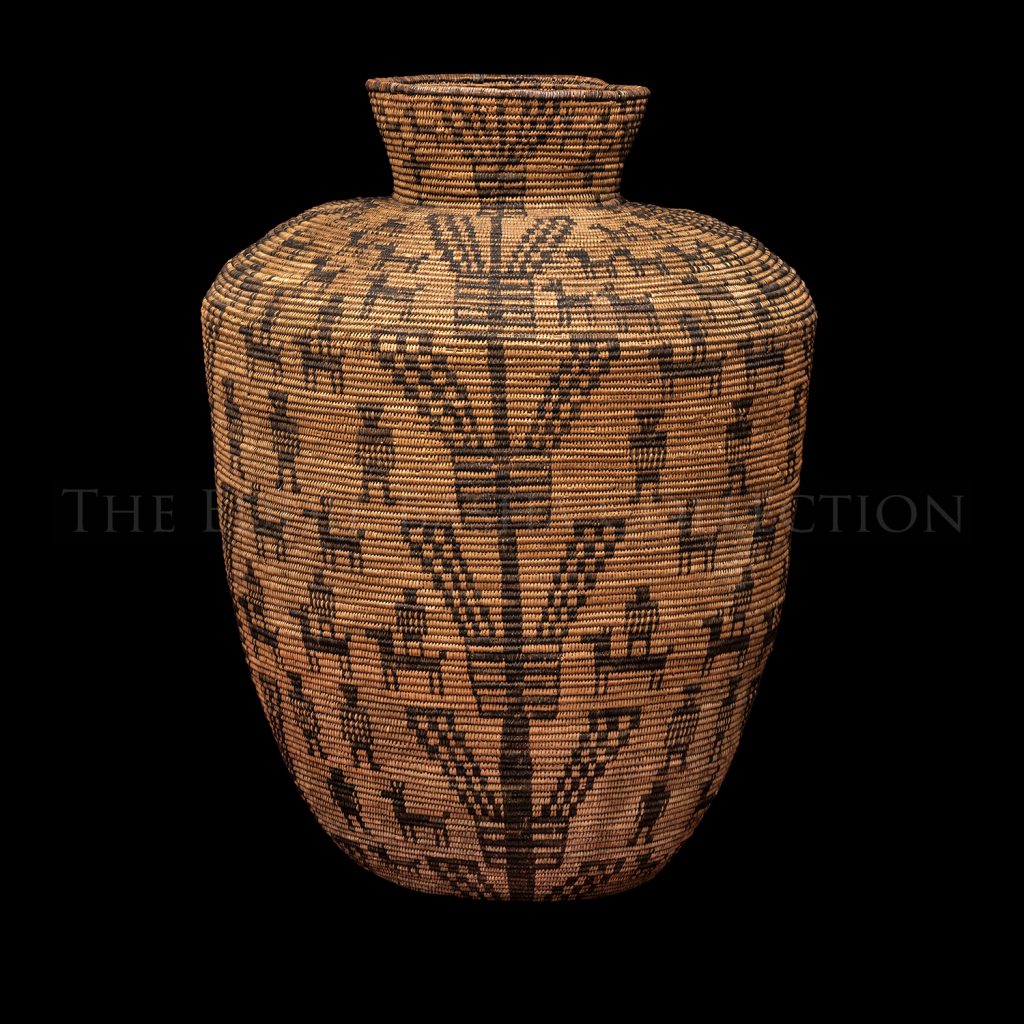 Willow & Devil’s Claw (Circa 1890) | Dimensions: 25”h x 21”w
Willow & Devil’s Claw (Circa 1890) | Dimensions: 25”h x 21”wThis colossal Apache Olla basket, circa 1890, is split into four quadrants by stylized tree of life elements with multiple horizontal rows of human, dog and deer figures. Two of the rows show humans standing on large dogs or horses. Four crosses are placed around the mouth. It was woven with willow and devil’s claw over a three-rod foundation.
Apache Olla | Unknown Artist
Artist: Apache
Description:
Willow & Devil’s Claw (Circa 1890) | Dimensions: 25”h x 21”w
This colossal Apache Olla basket, circa 1890, is split into four quadrants by stylized tree of life elements with multiple horizontal rows of human, dog and deer figures. Two of the rows show humans standing on large dogs or horses. Four crosses are placed around the mouth. It was woven with willow and devil’s claw over a three-rod foundation.
basketsThis colossal Apache Olla basket, circa 1890, is split into four quadrants by stylized tree of life elements with multiple horizontal rows of human, dog and deer figures. Two of the rows show humans standing on large dogs or horses. Four crosses are placed around the mouth. It was woven with willow and devil’s claw over a three-rod foundation.
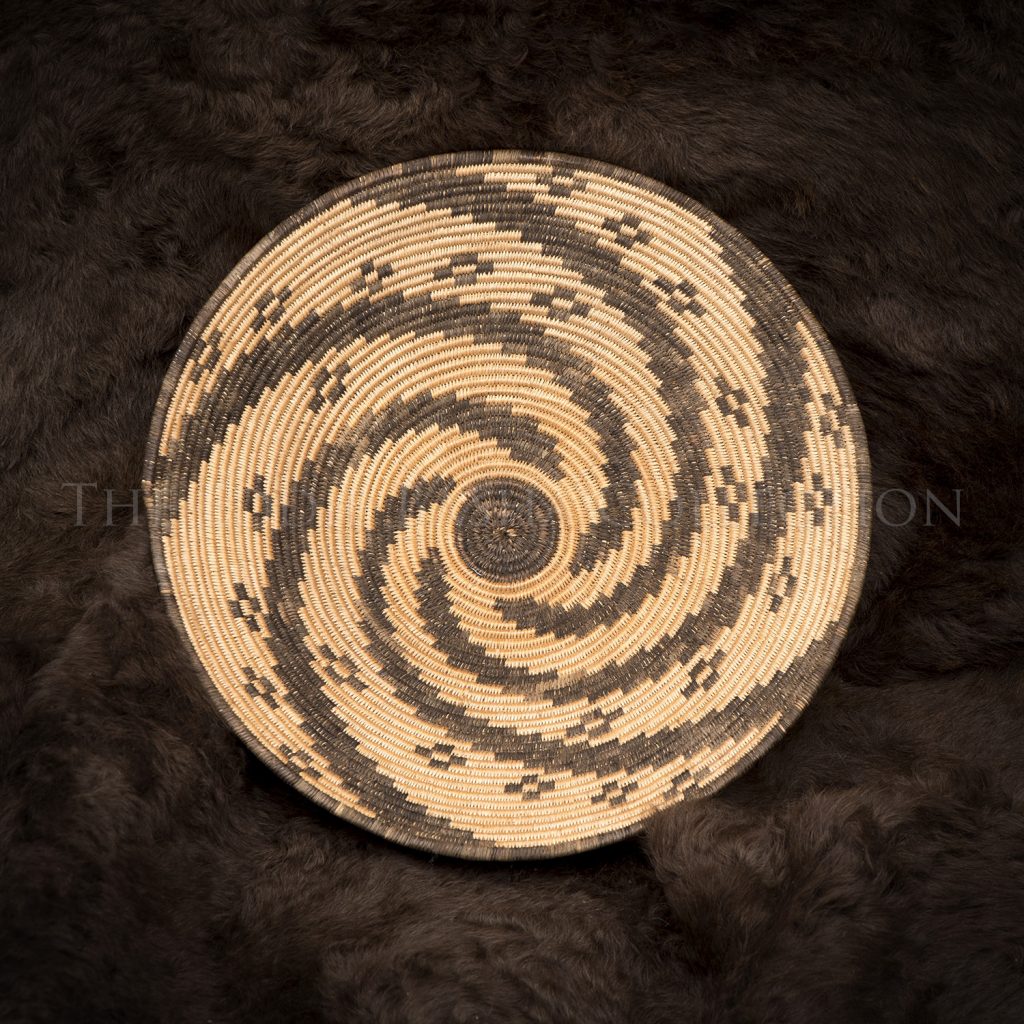 Basket (c.1910) | Dimensions: 14 ¾” Diameter
Basket (c.1910) | Dimensions: 14 ¾” DiameterIn this San Carlos Apache Tray, circa 1910, there are five black whirlwind swirling elements imparting a dynamic sense of motion. In the willow field, five separate coyote tracks outline the terraced devil’s claw swirling elements. Willow, devil’s claw over three-rod foundation.
San Carlos Apache Tray
Artist: Apache
Description:
Basket (c.1910) | Dimensions: 14 ¾” Diameter
In this San Carlos Apache Tray, circa 1910, there are five black whirlwind swirling elements imparting a dynamic sense of motion. In the willow field, five separate coyote tracks outline the terraced devil’s claw swirling elements. Willow, devil’s claw over three-rod foundation.
basketsIn this San Carlos Apache Tray, circa 1910, there are five black whirlwind swirling elements imparting a dynamic sense of motion. In the willow field, five separate coyote tracks outline the terraced devil’s claw swirling elements. Willow, devil’s claw over three-rod foundation.
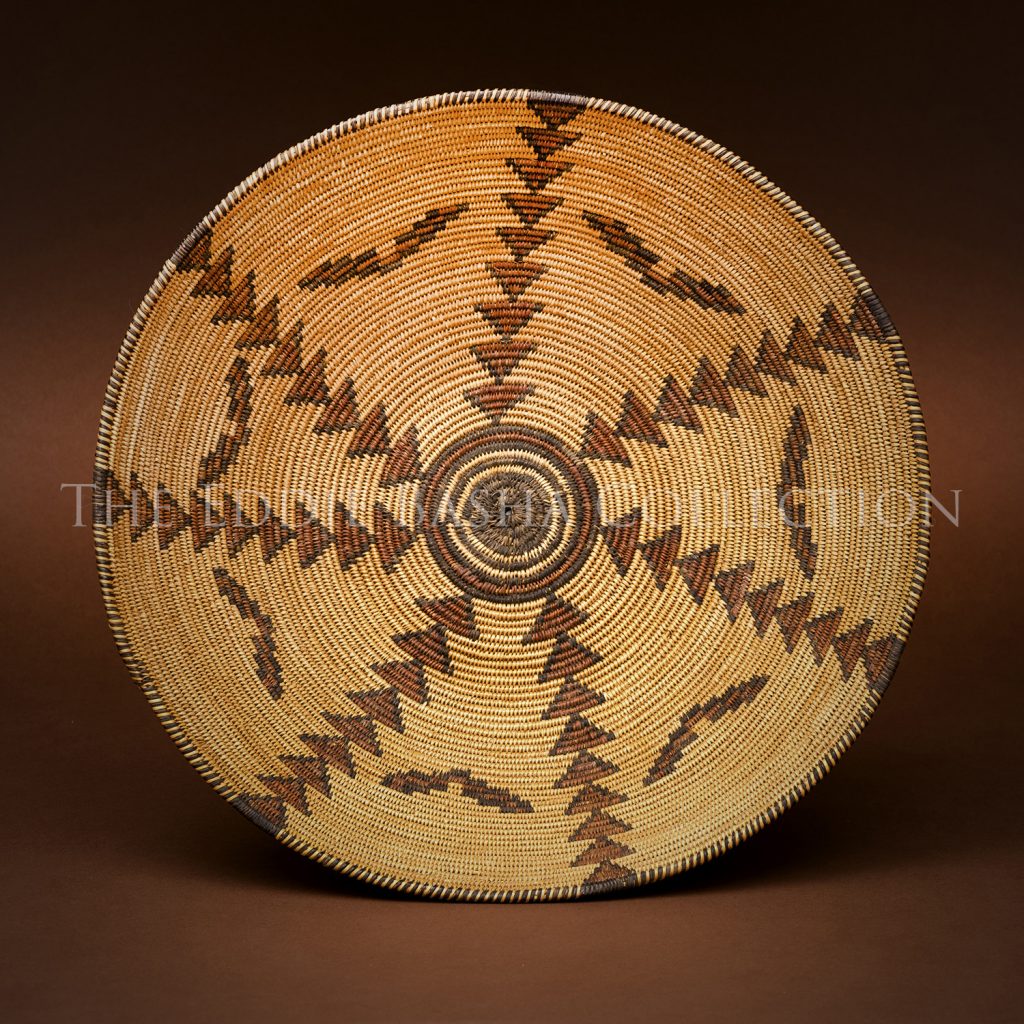 Willow, Devil’s Claw & Yucca Root (Circa 1930) | Dimensions: 16”
Willow, Devil’s Claw & Yucca Root (Circa 1930) | Dimensions: 16”Enjoy this 16” polychrome Apache bowl, circa 1930, displaying seven rows of stacked triangles between seven elements that could be birds, butterflies or bees. There is ticking all around the rim. Most likely this basket is a White Mountain Apache bowl because of the abundance of red yucca root which is a higher growing plant than that which is encountered on the lower elevation of the San Carlos Reservation. It is woven with willow, devil’s claw and yucca root over a three-rod foundation.
Apache Bowl
Artist: Apache
Description:
Willow, Devil’s Claw & Yucca Root (Circa 1930) | Dimensions: 16”
Enjoy this 16” polychrome Apache bowl, circa 1930, displaying seven rows of stacked triangles between seven elements that could be birds, butterflies or bees. There is ticking all around the rim. Most likely this basket is a White Mountain Apache bowl because of the abundance of red yucca root which is a higher growing plant than that which is encountered on the lower elevation of the San Carlos Reservation. It is woven with willow, devil’s claw and yucca root over a three-rod foundation.
basketsEnjoy this 16” polychrome Apache bowl, circa 1930, displaying seven rows of stacked triangles between seven elements that could be birds, butterflies or bees. There is ticking all around the rim. Most likely this basket is a White Mountain Apache bowl because of the abundance of red yucca root which is a higher growing plant than that which is encountered on the lower elevation of the San Carlos Reservation. It is woven with willow, devil’s claw and yucca root over a three-rod foundation.
 Willow and devil's claw; three-rod foundation (c.1900) | Dimensions: 16”
Willow and devil's claw; three-rod foundation (c.1900) | Dimensions: 16”This 16” Apache tray, circa 1900, features a delicate, eight-point star that expands into checkered elements, then a twelve-point star which also expands into checkered elements, and culminates with thirty-one dog figures at the rim. It is woven with willow and devil’s claw over a three-rod foundation.
Apache Basket
Artist: Apache
Description:
Willow and devil's claw; three-rod foundation (c.1900) | Dimensions: 16”
This 16” Apache tray, circa 1900, features a delicate, eight-point star that expands into checkered elements, then a twelve-point star which also expands into checkered elements, and culminates with thirty-one dog figures at the rim. It is woven with willow and devil’s claw over a three-rod foundation.
basketsThis 16” Apache tray, circa 1900, features a delicate, eight-point star that expands into checkered elements, then a twelve-point star which also expands into checkered elements, and culminates with thirty-one dog figures at the rim. It is woven with willow and devil’s claw over a three-rod foundation.
 Unknown Artist
Unknown ArtistContemporary Apache Burden Baskets such as the one shown here are typically used for ceremonial or ornamental purposes. The tassels are often made from cow or deer hides and the tin, though now decorative, were once thought to ward off snakes while functioning as a utilitarian piece when foraging for food, cultivating crops, collecting firewood and even hauling water. And when male suitors were granted permission for a female’s hand in marriage by her mother, it is said that husband’s-to-be, alerted by the rattling of the tin cones, would know that he wasn’t to look at his future mother-in-law as an ultimate act of respect.
Apache Burden Basket
Artist: Apache
Description:
Unknown Artist
Contemporary Apache Burden Baskets such as the one shown here are typically used for ceremonial or ornamental purposes. The tassels are often made from cow or deer hides and the tin, though now decorative, were once thought to ward off snakes while functioning as a utilitarian piece when foraging for food, cultivating crops, collecting firewood and even hauling water. And when male suitors were granted permission for a female’s hand in marriage by her mother, it is said that husband’s-to-be, alerted by the rattling of the tin cones, would know that he wasn’t to look at his future mother-in-law as an ultimate act of respect.
basketsContemporary Apache Burden Baskets such as the one shown here are typically used for ceremonial or ornamental purposes. The tassels are often made from cow or deer hides and the tin, though now decorative, were once thought to ward off snakes while functioning as a utilitarian piece when foraging for food, cultivating crops, collecting firewood and even hauling water. And when male suitors were granted permission for a female’s hand in marriage by her mother, it is said that husband’s-to-be, alerted by the rattling of the tin cones, would know that he wasn’t to look at his future mother-in-law as an ultimate act of respect.
 In the foreground, this early Apache olla, circa 1880, presents with a prehistoric ceramic motif consisting of six horizontal zigzag bands against a black devil’s claw field that progresses toward the neck while the neck consists of checkered and cross elements. It was woven with willow and devil’s claw over a three-rod foundation. It measures 13 ½” x 13 ½”.
In the foreground, this early Apache olla, circa 1880, presents with a prehistoric ceramic motif consisting of six horizontal zigzag bands against a black devil’s claw field that progresses toward the neck while the neck consists of checkered and cross elements. It was woven with willow and devil’s claw over a three-rod foundation. It measures 13 ½” x 13 ½”.The Apache olla behind, circa 1900, is a well-balanced basket both in design and form, starting with an eight-pointed star at the base and followed by a heavily terraced diagonal motif going from left to right and from the base to the rim. Two rows of spaced coyote tracks grace the shoulder. It too was woven with willow and devil’s claw over a three-rod foundation. It stands 20 ½”h and has an 18” diameter.
Apache Olla Basket
Artist: Apache
Description:
In the foreground, this early Apache olla, circa 1880, presents with a prehistoric ceramic motif consisting of six horizontal zigzag bands against a black devil’s claw field that progresses toward the neck while the neck consists of checkered and cross elements. It was woven with willow and devil’s claw over a three-rod foundation. It measures 13 ½” x 13 ½”.
The Apache olla behind, circa 1900, is a well-balanced basket both in design and form, starting with an eight-pointed star at the base and followed by a heavily terraced diagonal motif going from left to right and from the base to the rim. Two rows of spaced coyote tracks grace the shoulder. It too was woven with willow and devil’s claw over a three-rod foundation. It stands 20 ½”h and has an 18” diameter.
basketsThe Apache olla behind, circa 1900, is a well-balanced basket both in design and form, starting with an eight-pointed star at the base and followed by a heavily terraced diagonal motif going from left to right and from the base to the rim. Two rows of spaced coyote tracks grace the shoulder. It too was woven with willow and devil’s claw over a three-rod foundation. It stands 20 ½”h and has an 18” diameter.
 (Circa 1920) | 18” Diameter
(Circa 1920) | 18” DiameterThis 18” Apache Tray, circa 1920, features an elaborate unfolding of a five-pointed star done in devil’s claw at its base, then willow and again outlined in devil’s claw which formed the illusion of stylized arrowheads inside the black field. Fine checkered elements add to the basket’s appeal as do the sharp double tips at the end of the five petals. Five deer balance the motif at the rim. This tray was woven over a three-rod foundation.
Apache Tray
Artist: Apache
Description:
(Circa 1920) | 18” Diameter
This 18” Apache Tray, circa 1920, features an elaborate unfolding of a five-pointed star done in devil’s claw at its base, then willow and again outlined in devil’s claw which formed the illusion of stylized arrowheads inside the black field. Fine checkered elements add to the basket’s appeal as do the sharp double tips at the end of the five petals. Five deer balance the motif at the rim. This tray was woven over a three-rod foundation.
basketsThis 18” Apache Tray, circa 1920, features an elaborate unfolding of a five-pointed star done in devil’s claw at its base, then willow and again outlined in devil’s claw which formed the illusion of stylized arrowheads inside the black field. Fine checkered elements add to the basket’s appeal as do the sharp double tips at the end of the five petals. Five deer balance the motif at the rim. This tray was woven over a three-rod foundation.
 Willow & Devil’s Claw (Circa 1920) | Dimensions: 21 3/8” diameter x 4 ¾” deep
Willow & Devil’s Claw (Circa 1920) | Dimensions: 21 3/8” diameter x 4 ¾” deepIf you haven’t visited, the Native American Basket collection alone is certain to delight and amaze you with its quality and depth. There are over 350 baskets on display at any given time.
This selection spans 21 3/8” across and 4 ¾” deep. This Apache tray, circa 1920’s, begins with a seven-pointed star at its base and eleven pairs of human figures and dogs circle the star. Seventeen additional human figures and over twenty dogs complete the rim. It is woven with willow and devil’s claw over a three-rod foundation.
Apache Tray
Artist: Apache
Description:
Willow & Devil’s Claw (Circa 1920) | Dimensions: 21 3/8” diameter x 4 ¾” deep
If you haven’t visited, the Native American Basket collection alone is certain to delight and amaze you with its quality and depth. There are over 350 baskets on display at any given time.
This selection spans 21 3/8” across and 4 ¾” deep. This Apache tray, circa 1920’s, begins with a seven-pointed star at its base and eleven pairs of human figures and dogs circle the star. Seventeen additional human figures and over twenty dogs complete the rim. It is woven with willow and devil’s claw over a three-rod foundation.
basketsIf you haven’t visited, the Native American Basket collection alone is certain to delight and amaze you with its quality and depth. There are over 350 baskets on display at any given time.
This selection spans 21 3/8” across and 4 ¾” deep. This Apache tray, circa 1920’s, begins with a seven-pointed star at its base and eleven pairs of human figures and dogs circle the star. Seventeen additional human figures and over twenty dogs complete the rim. It is woven with willow and devil’s claw over a three-rod foundation.
 Basket (Circa 1890) | 19” Diameter
Basket (Circa 1890) | 19” DiameterWoven with willow and devil’s claw over a three-rod foundation, this magnificent geometrically terraced Apache tray is very finely woven, especially for its size. Five rows form a maze-like pattern and the final two rows below the rim have diamonds placed between the terraces.
Apache Tray
Artist: Apache
Description:
Basket (Circa 1890) | 19” Diameter
Woven with willow and devil’s claw over a three-rod foundation, this magnificent geometrically terraced Apache tray is very finely woven, especially for its size. Five rows form a maze-like pattern and the final two rows below the rim have diamonds placed between the terraces.
basketsWoven with willow and devil’s claw over a three-rod foundation, this magnificent geometrically terraced Apache tray is very finely woven, especially for its size. Five rows form a maze-like pattern and the final two rows below the rim have diamonds placed between the terraces.
 Basket (Circa 1900) | 20” Diameter
Basket (Circa 1900) | 20” DiameterThis Apache tray was woven with willow and devil’s claw over a three-rod foundation. A five-pointed star divides vertical botanical elements, possibly cornstalks, upward to the rim. These unique designs also resemble feathers. Above the points on the star are two vertical squares with a pair of dogs to the left and right of the higher square just below the rim.
Apache Tray
Artist: Apache
Description:
Basket (Circa 1900) | 20” Diameter
This Apache tray was woven with willow and devil’s claw over a three-rod foundation. A five-pointed star divides vertical botanical elements, possibly cornstalks, upward to the rim. These unique designs also resemble feathers. Above the points on the star are two vertical squares with a pair of dogs to the left and right of the higher square just below the rim.
basketsThis Apache tray was woven with willow and devil’s claw over a three-rod foundation. A five-pointed star divides vertical botanical elements, possibly cornstalks, upward to the rim. These unique designs also resemble feathers. Above the points on the star are two vertical squares with a pair of dogs to the left and right of the higher square just below the rim.
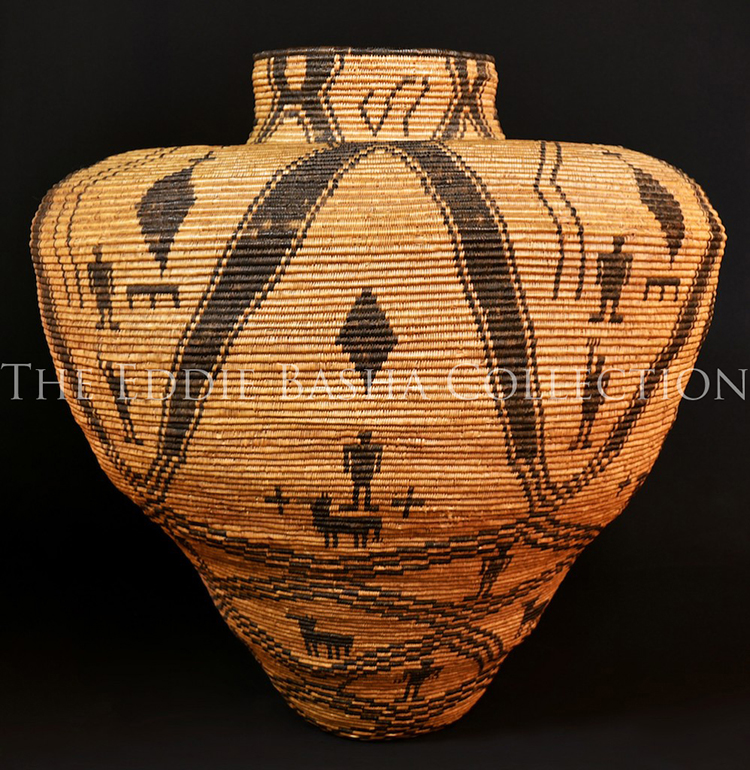 (1885) | The basket starts with a five-pointed star at the base and forms diamonds with men and horses within. A third of the way up from the basket base, the field becomes more open and within the five massive black diamonds there are men, horses, crosses and various geometric elements. More crosses and random diagonal lines decorate the mouth. Willow, devil’s claw, over three-rod foundation.
(1885) | The basket starts with a five-pointed star at the base and forms diamonds with men and horses within. A third of the way up from the basket base, the field becomes more open and within the five massive black diamonds there are men, horses, crosses and various geometric elements. More crosses and random diagonal lines decorate the mouth. Willow, devil’s claw, over three-rod foundation.This large Apache Olla Basket displayed was once gifted to one of Arizona’s most notable female pioneers, Cordelia Crawford. The story has been told many times and as we understand it, Cordelia was somewhat of a pediatrician. This fact became well known throughout the region. In as much as Cordelia and her family settled in the area just outside of present day Globe, the Apache women would lay their sick children in front of Cordelia’s home. She would take them in, nurse them to good health and place them back outside once they were well enough to return. During that time as Apache raiding parties would traverse the eastern part of Arizona, the Crawford Ranch was never breached in deference to her.
At some point, Cordelia acquired this beautiful Apache basket and it had remained in the Crawford family and was passed on for many years. It wasn’t until very recent, the later part of the 1990’s, did that basket become available for sale. Not only are we proud to share the history of this particular Olla Basket with you, but subsequently we have come to find out that the wife of one of our company’s vice presidents is a descendant of Cordelia’s. It’s a small world after all. She, too, has a basket or two in her home and promises to one day share another part of her family’s legacy with all of us. We impatiently await that time.
Apache Olla Basket
Artist: Apache
Description:
(1885) | The basket starts with a five-pointed star at the base and forms diamonds with men and horses within. A third of the way up from the basket base, the field becomes more open and within the five massive black diamonds there are men, horses, crosses and various geometric elements. More crosses and random diagonal lines decorate the mouth. Willow, devil’s claw, over three-rod foundation.
This large Apache Olla Basket displayed was once gifted to one of Arizona’s most notable female pioneers, Cordelia Crawford. The story has been told many times and as we understand it, Cordelia was somewhat of a pediatrician. This fact became well known throughout the region. In as much as Cordelia and her family settled in the area just outside of present day Globe, the Apache women would lay their sick children in front of Cordelia’s home. She would take them in, nurse them to good health and place them back outside once they were well enough to return. During that time as Apache raiding parties would traverse the eastern part of Arizona, the Crawford Ranch was never breached in deference to her.
At some point, Cordelia acquired this beautiful Apache basket and it had remained in the Crawford family and was passed on for many years. It wasn’t until very recent, the later part of the 1990’s, did that basket become available for sale. Not only are we proud to share the history of this particular Olla Basket with you, but subsequently we have come to find out that the wife of one of our company’s vice presidents is a descendant of Cordelia’s. It’s a small world after all. She, too, has a basket or two in her home and promises to one day share another part of her family’s legacy with all of us. We impatiently await that time.
basketsThis large Apache Olla Basket displayed was once gifted to one of Arizona’s most notable female pioneers, Cordelia Crawford. The story has been told many times and as we understand it, Cordelia was somewhat of a pediatrician. This fact became well known throughout the region. In as much as Cordelia and her family settled in the area just outside of present day Globe, the Apache women would lay their sick children in front of Cordelia’s home. She would take them in, nurse them to good health and place them back outside once they were well enough to return. During that time as Apache raiding parties would traverse the eastern part of Arizona, the Crawford Ranch was never breached in deference to her.
At some point, Cordelia acquired this beautiful Apache basket and it had remained in the Crawford family and was passed on for many years. It wasn’t until very recent, the later part of the 1990’s, did that basket become available for sale. Not only are we proud to share the history of this particular Olla Basket with you, but subsequently we have come to find out that the wife of one of our company’s vice presidents is a descendant of Cordelia’s. It’s a small world after all. She, too, has a basket or two in her home and promises to one day share another part of her family’s legacy with all of us. We impatiently await that time.
 (1920) | Eleven-pointed star in center is supporting eleven hour-glass elements and eleven whirling logs with a feather motif at the rim. Willow, devil’s claw over three-rod foundation.
(1920) | Eleven-pointed star in center is supporting eleven hour-glass elements and eleven whirling logs with a feather motif at the rim. Willow, devil’s claw over three-rod foundation.When the first Navajo man and woman emerged from the underworld called The Third World, a water world, they bore a son. A few years later, the son was so intrigued about the stories he had heard about the underworld that he went back to the place of emergence and while looking down fell in. His father then went after him to rescue his son among the endless rivers of the underworld. After uniting there, they were thrown into the classic ancient legend, similar to the Illiad and Odyssey, where on their long and perilous journey they experienced and learned the heritage and lessons of Navajo medicine, which all had originated there. At the completion of their journey, harboring all of this valuable knowledge, they were attempting to exit the underworld when they were attacked by The Water Monsters. Just as the father and son were about to perish, two logs formed a cross in the water and four Yeis (holy messengers) appeared at the tips of the logs, forming a swastika-like shape. The Yeis promised to save them if the father and son would get on to the logs and believe in them, giving the Yeis their full confidence and faith. The father and son agreed and the Yeis whirled them back to the present world and safety. Thus, the Whirling Logs became the symbol that to this day is cherished as a reminder of the link that preserves their sacred medicine and traditions. The Navajo were forbidden to incorporate this symbol on their art during the 1930s because of Nazi Germany, but it is still seen in the traditional sand paintings that are used to cure their people during the Yei-Be-Chai healing ceremonies.
Whirling logs are seen in Apache, Yavapai, Hopi, Havasupai, Chemehuevi, Pima and Tohono O’odham baskets as well as in various Great Basin and California basketry. Here they take on the concept of the four cardinal directions, as well as a depiction of one complete lifespan, or generation: the four points of the symbol representing birth, youth, old age and death. As seen in examples here in the gallery, some Pima weavers artistically linked several of the whirling logs together in continuous circular patterns, thus binding one generation to another both in the past and future. This motif was sacred to many Native Americans throughout the Americas.
Hopefully this information will answer the question about the use of the symbol and release the stigma associated with it. Not only have Native Americans utilized it in their culture, but so have the Hindus, Buddhists, Chinese, early Egyptians, Phoenicians, Etruscans, Greeks and Romans, long before it was stigmatized by its use in such a negative fashion.
The Whirling Logs
Artist: Apache
Description:
(1920) | Eleven-pointed star in center is supporting eleven hour-glass elements and eleven whirling logs with a feather motif at the rim. Willow, devil’s claw over three-rod foundation.
When the first Navajo man and woman emerged from the underworld called The Third World, a water world, they bore a son. A few years later, the son was so intrigued about the stories he had heard about the underworld that he went back to the place of emergence and while looking down fell in. His father then went after him to rescue his son among the endless rivers of the underworld. After uniting there, they were thrown into the classic ancient legend, similar to the Illiad and Odyssey, where on their long and perilous journey they experienced and learned the heritage and lessons of Navajo medicine, which all had originated there. At the completion of their journey, harboring all of this valuable knowledge, they were attempting to exit the underworld when they were attacked by The Water Monsters. Just as the father and son were about to perish, two logs formed a cross in the water and four Yeis (holy messengers) appeared at the tips of the logs, forming a swastika-like shape. The Yeis promised to save them if the father and son would get on to the logs and believe in them, giving the Yeis their full confidence and faith. The father and son agreed and the Yeis whirled them back to the present world and safety. Thus, the Whirling Logs became the symbol that to this day is cherished as a reminder of the link that preserves their sacred medicine and traditions. The Navajo were forbidden to incorporate this symbol on their art during the 1930s because of Nazi Germany, but it is still seen in the traditional sand paintings that are used to cure their people during the Yei-Be-Chai healing ceremonies.
Whirling logs are seen in Apache, Yavapai, Hopi, Havasupai, Chemehuevi, Pima and Tohono O’odham baskets as well as in various Great Basin and California basketry. Here they take on the concept of the four cardinal directions, as well as a depiction of one complete lifespan, or generation: the four points of the symbol representing birth, youth, old age and death. As seen in examples here in the gallery, some Pima weavers artistically linked several of the whirling logs together in continuous circular patterns, thus binding one generation to another both in the past and future. This motif was sacred to many Native Americans throughout the Americas.
Hopefully this information will answer the question about the use of the symbol and release the stigma associated with it. Not only have Native Americans utilized it in their culture, but so have the Hindus, Buddhists, Chinese, early Egyptians, Phoenicians, Etruscans, Greeks and Romans, long before it was stigmatized by its use in such a negative fashion.
basketsWhen the first Navajo man and woman emerged from the underworld called The Third World, a water world, they bore a son. A few years later, the son was so intrigued about the stories he had heard about the underworld that he went back to the place of emergence and while looking down fell in. His father then went after him to rescue his son among the endless rivers of the underworld. After uniting there, they were thrown into the classic ancient legend, similar to the Illiad and Odyssey, where on their long and perilous journey they experienced and learned the heritage and lessons of Navajo medicine, which all had originated there. At the completion of their journey, harboring all of this valuable knowledge, they were attempting to exit the underworld when they were attacked by The Water Monsters. Just as the father and son were about to perish, two logs formed a cross in the water and four Yeis (holy messengers) appeared at the tips of the logs, forming a swastika-like shape. The Yeis promised to save them if the father and son would get on to the logs and believe in them, giving the Yeis their full confidence and faith. The father and son agreed and the Yeis whirled them back to the present world and safety. Thus, the Whirling Logs became the symbol that to this day is cherished as a reminder of the link that preserves their sacred medicine and traditions. The Navajo were forbidden to incorporate this symbol on their art during the 1930s because of Nazi Germany, but it is still seen in the traditional sand paintings that are used to cure their people during the Yei-Be-Chai healing ceremonies.
Whirling logs are seen in Apache, Yavapai, Hopi, Havasupai, Chemehuevi, Pima and Tohono O’odham baskets as well as in various Great Basin and California basketry. Here they take on the concept of the four cardinal directions, as well as a depiction of one complete lifespan, or generation: the four points of the symbol representing birth, youth, old age and death. As seen in examples here in the gallery, some Pima weavers artistically linked several of the whirling logs together in continuous circular patterns, thus binding one generation to another both in the past and future. This motif was sacred to many Native Americans throughout the Americas.
Hopefully this information will answer the question about the use of the symbol and release the stigma associated with it. Not only have Native Americans utilized it in their culture, but so have the Hindus, Buddhists, Chinese, early Egyptians, Phoenicians, Etruscans, Greeks and Romans, long before it was stigmatized by its use in such a negative fashion.